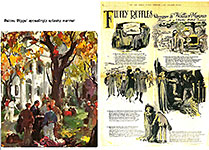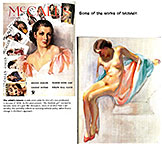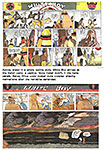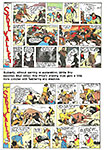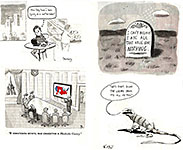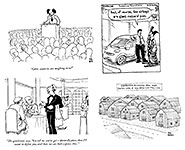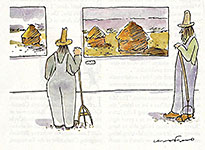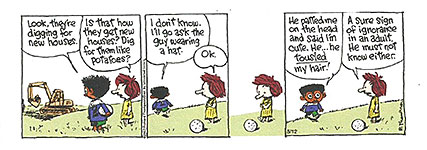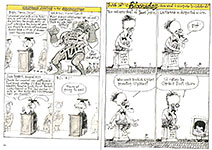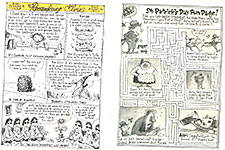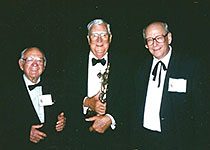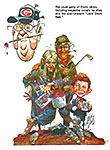 |
||||||||||||||||||||||||||||||
Opus 356 (August 20, 2016). Back to the old Rabbit Habit routine. Open Access Month is over, and the doors at Rancid Raves have slammed shut again except for $ubscribers. (But if you liked what you saw over the last month, consider joining us as a $ubscriber for a paltry $3.95/quarter after an initial $3.95 introductory month fee.) On the other side of the barricade, we report the first interview in the West with Iran’s Atena since her release and why Frank Cho quit his DC project drawing alternate covers for Wonder Woman. We round up some of the editoons committed during the politically fraught July and we review Adam Hughes’ Betty & Veronica, Kareem Abdul-Jabbar’s Mycroft Holmes, Garrett Price’s unique White Boy, and a clutch of barenekkidwimmin comic books, one of which veers off into sadistic eroticism . We ponder cartooning at The New Yorker and deliver our final report on attending the San Diego Comic-Con (this one’ll be my last one). And we explain why superheroines won’t work in a politically correct environment. We also bid farewell to cartooning giant Jack Davis and the antic cartooning talent Richard Thompson. This posting, you’ll see, is huge. We just can’t shut up. But that’s what it’s all about, eh? Talking about comics. That’s what we do here. But every time we get ready to post, the Trumpet blasts a new outrage and editoonists leap to their drawingboards, and we have even more to say. So we admit: there’s more here than can be read at a single sitting. We recommend using the contents listed below as a shopping list: scan the items listed and pick those that interest you; then scroll rapidly down to the ones you’ve picked, skipping over boring stuff. Politics and editooning spirals nearly out-of-control this time because of the political conventions and the Prez Election shenanigans; but if you’re not into politics, skip all that and go on to what you like Here’s what’s here, in order, by department—:
NOUS R US Iran’s Atena Interviewed LA Times Wants $300,000 in Advance Fees from Ted Rall Frank Cho Quits DC Comics Pearls Yanked Because of ISIS Joke Ramirez Finds Work Captain America Statue Not Welcome in Brooklyn Superheroines and Violence Politically Incorrect Joe Giella Retires from Mary Worth
REPORT ON MY LAST SANDY EGGO CON Sergio Gets Icon Award David Siegel Gets Alter Ego Cover Story FUNNYBOOK FAN FARE Adam Hughes’ Betty & Veronica Kareem Abdul-Jabbar’s Mycroft Holmes Black Hammer Barenekkidwimmin and Sadistic Comics
EDITOONERY The Political Conventions Presidential Campaign Trump and Hillary —July Was a Fun Month
Cutting Off Trump’s Tweeter Explaining the Trumpster Trumpster Dumpster: What’s In a Name?
THE FROTH ESTATE Journalism Fails —And Succeeds at Time’s 240 Issue
NEWSPAPER COMICS PAGE VIGIL What’s Happenin’ On the Funnies Pages
BOOK MARQUEE Masters of American Illustration — including some cartoonists Garrett Price’s White Boy in Skull Valley
Jules Feiffer’s Next Graphic Novel
A-GAGGING WE GO Magazine Cartooning at The New Yorker Michael Crawford’s Puzzler Unpuzzled
ONWARD, THE SPREADING PUNDITRY
PASSIN’ THROUGH— Richard Thompson Jack Davis (With an Aside for Aussie Jim Russell)
QUOTE OF THE MONTH If Not of A Lifetime “Goddamn it, you’ve got to be kind.”—Kurt Vonnegut
Our Motto: It takes all kinds. Live and let live. Wear glasses if you need ’em. But it’s hard to live by this axiom in the Age of Tea Baggers, so we’ve added another motto:.
Seven days without comics makes one weak. (You can’t have too many mottos.)
And our customary reminder: don’t forget to activate the “Bathroom Button” by clicking on the “print friendly version” so you can print off a copy of just this installment for reading later, at your leisure while enthroned. Without further adieu, then, here we go—:
NOUS R US Some of All the News That Gives Us Fits
IRANIAN ARTIST SPEAKS TO THE WEST Maren Williams at the Comic Book Legal Defense Fund provides an introduction (in italics) to the interview Atena Farghadani gave in mid-July to the Washington Post’s Michael Cavna—: Just over two months ago, Iranian artist and activist Atena Farghadani was freed from prison after her draconian prison sentence of 12 years and 9 months for mocking her country’s parliament in a cartoon was shortened to the 18 months she’d already served. (See Opus 355 for a succinct recitation of her story.—RCH) Evin Prison, the Tehran lockup where Farghadani spent most of her incarceration, is almost invariably described in Western media as “notorious.” But in fact, she tells Cavna that the women’s prison at Gharchak where she was initially detained is even worse. It was there that she went on a prolonged hunger strike which resulted in cardiac arrest before she was moved to Evin. Last month, she gave an exclusive interview to Cavna about her time in prison, her plans for the future, and her conviction that she is obligated to keep making art in Iran, no matter the consequences. Here’s Cavna—:
OF THE THOUSANDS of artists I have interviewed over the years, few have been as demonstrably brave as Atena Farghadani. Today, Atena vows to continue to make political art from within Iran, where her voice may have the greatest effect. This is an exclusive Q&A with Ms. Farghadani, in her first interview with the Western press since winning her release. The interview was conducted via email with the help of Nikahang Kowsar, the Iranian-born cartoonist and board member of the Washington-based Cartoonists Rights Network International, who himself was jailed in Iran in 2000 for his art. This interview has been edited for clarity and length. MICHAEL CAVNA: First off, Ms. Farghadani, let me just say, now that the opportunity finally provides: congratulations on your freedom. We heard reports about the difficult conditions while you were imprisoned. How are you feeling, and doing? And how does one even recover from a mental and physical ordeal such as yours? ATENA FARGHADANI: I appreciate all the efforts you and your colleagues have made so far. My feelings at the moment are not very pleasant because it’s like I’m stuck in a limbo. Obviously, the mental weariness of imprisonment is more serious than the physical problems caused by it. At the moment, since I’ve arrived at the certainty that there is miracle lying in the art of drawing and painting, I’m more determined to continue doing it than ever. MC: You, of course, have become an inspiration to so many around the world, Atena — a beacon of creative and political resistance. While you were in prison — Evin and elsewhere — how aware were of you of the degree to which the outside world knew and was following your story? Was Mohammad Moghimi [her lawyer] able to provide you with news in that regard during your case? AF: When I was in prison, I wasn’t aware of outside events and the news about me, especially in 2015, when I was on a hunger strike in the gruesome Gharchak prison. At that point, I was absolutely hopeless and thought I would die there, without my voice ever being heard. But I kept going with the strike, constantly thinking that even if I die, I have a clear conscience for I’ve died for my beliefs and goals. After my appeal to be transferred to Evin prison was approved and I ended my hunger strike, my attorney, Mr. Moghimi, gave me all news in two very short visits, boosting my morale and giving me hope. MC: One aspect of the ordeal of being in an Iranian prison was not knowing one’s fate — feeling as though you are in the legal hands of a system that might not practice justice as you, the prisoner, might understand it, and all the uncertainty. Could you talk about what was hardest for you about your long detentions and imprisonment — and whether you thought you might actually spend more than 13 years behind bars for your outspokenness and artwork? AF: When I heard my sentence of 12 years and nine months imprisonment, I thought it was unbelievable and very unjust. Since I was 29 at the time, I calculated that I’d have to be in prison till I’m 42. At first, I had a hard time accepting the sentence, but then I thought I could use this time, as much as possible, to draw and have an opportunity to put an exhibition of my works after my release. I considered prison my home for the next 13 years. My family could not accept this new attitude of mine towards prison and my beliefs, and at times they were frightened by it and wept. At these times, I had no choice but to make faces for them from behind the glass in the visitation cabin to make them laugh. These were the hardest and most bitter days I had during my incarceration. MC: Why do you think you were ultimately awarded your freedom? What swayed the legal system? AF: As the results of the efforts made by my family and my attorney, Mr. Moghimi, and pressures from the international community and human rights organizations, my sentence was reduced from 12 years and nine months to 18 months and a three-year suspended sentence for insulting the supreme leader of Iran. I am grateful to all those whom I don’t know and to whom I owe my freedom. MC: Is there anything about your case [including the reported “virginity test" after shaking your male attorney’s hand] that we should know about that we might not know? AF: Yes, that’s … caused lots of confusion: Considering the fact that my family had refuted that I was tested for virginity and pregnancy because of shaking hands with my lawyer, people wanted to know the truth. The truth is that my family was in denial at the time because of the dominant traditions and the Iranian culture and fear for more pressure from the judiciary on me. But the tests were actually made, which led to my three-day dry hunger strike in objection. The Islamic Republic of Iran later confirmed this event. It is noteworthy that both my attorney and I were exonerated from the adultery accusations and I owe this to the judge of this specific case, who issued our exoneration verdict independently and neutrally in spite of the sensitivity of the case and security pressures. MC: What art are you making now — and will your art remain political, or might you steer your art and activism in a different direction? AF: Right now, I’m painting and making a collection of artwork with political and social contents, and I intend to have an exhibition within a year, but I’m afraid I can’t hold this exhibition in Iran, and thus I’m even thinking of having a street gallery, though it wouldn’t be without consequences. I believe that “criticism” serves art. So, I have decided to use my art to challenge social issues as I have done before, like the cartoon I drew after I was released as an objection to the dean of Al-Zahra University, who expelled me and many other students. [See Opus 355.] MC: Do you feel safe now in Iran, and can you see ever coming to visit America? AF: Of course, I could be more successful in developed countries, but when I witness the problems Iranians are dealing with, such as economic and cultural poverty and various limitations, I cannot leave them alone to live in another country in a better situation, despite all the constraints and issues I would possibly face. Many Iranians, though, have had to leave their homeland because of these constraints and have been active outside their country to improve human rights in Iran and are successful, too. But I don’t see it in me to be able to leave my country because of my emotional attachments, which is perhaps a weakness of mine, but as long as I live, I will stay here, even if I have to go to prison again. MC: Are you comfortable with being a symbol for artistic resistance and political freedom of expression? AF: I don’t consider myself a symbol. I simply acted on my thought, beliefs and principles, and I think all people have an individual and social task to fulfill. MC: Is there something I didn’t ask that you would especially like to tell readers? AF: Yes. One of the things that has had [a] destructive impact on me after my release was the incarceration in the gruesome Gharchak prison, which is for prisoners with all sorts of non-security crimes. What bothered me the most was to see inmates — many of whom were victims of the economic and cultural poverty in the Iranian system — who were not treated like human beings; their most basic rights were violated. I consider Gharchak prison as a graveyard of time … where time dies. I sometimes see those inmates in my nightmares. Once, I saw one of them collecting and braiding my fallen hair! I see myself as a reflection of other people, and to respond to this question of yours, I would like to reflect the wishes of other women imprisoned in Gharchak — most of them longed for cool drinking water, instead of the salty lukewarm water they had to drink from the tap. There were only four showers in each chamber for 189 inmates, with the same salty water for only an hour a day, so many of them missed a hot shower! Many of them [condemned to] death sentences wished to plant something that wouldn’t wither from the salty water and [to] see that plant — to leave a living mark before departing from this life.
ADDING INSULT TO INJURY Editoonist Ted Rall is currently suing the Los Angeles Times for defamation, blacklisting, wrongful termination and breach of contract; see Opus 350 for details. According to a press release from Rall’s attorneys, Shegerian & Associates, Inc., a Santa Monica-based litigation law firm specializing in employee rights, the newspaper’s initial response to Rall’s suit is its demand that Rall pay in advance $300,000 in “legal fees” to guarantee the Times’ attorney fees in the event they should win their anti-SLAPP motion. S&A characterized this maneuver as a “bully move against a freelance cartoonist by a corporation that is egregiously inverting the very anti-SLAPP statute designed to protect employees from big corporations.” The court has since ordered the Times to lower its request to $75,000. Said Rall: “It feels almost like they are forcing me to ‘pay to play’ if I am to see my day in court. You’d think after what happened, they would be issuing an apology and offering me my job back, not trying to bankrupt me after wrongfully firing me.” Rall was originally hired by the Times as an editorial cartoonist in 2009 and published approximately 300 of his cartoons and more than 60 of his blog posts in the paper between 2009 and 2015. At no time during his employment was Rall disciplined or written-up and he was consistently praised for his work. Then in the summer of 2015, Rall was summarily and publicly fired by the paper, which alleged that in a blog that May, Rall had posted untruths about his run-in with the Los Angeles police. Said S&A: “The Times' suspicions about the veracity of Mr. Rall’s blog post were unfounded in that they failed to properly investigate the accusations and refused to acknowledge proof that Mr. Rall’s blog post was, in fact, accurate. The public defamation and subsequent blacklisting of our client following blatantly wrongful termination should be enough of a slap in Mr. Rall’s face, but the demand now for this freelance cartoonist to pay the Times’ legal fees in advance of a trial demonstrates that not only does the LA Times not play by its own rules employment-wise, as we will demonstrate in court, it behaves in a vindictive and unfair manner as well.” The story of Rall’s adventure with the Times is detailed at Opus 342a.
CHO QUITS DC OVER ATTEMPTED CENSORING OF HIS WORK New Creation in the Wings Famed limner of the curvaceous gender Frank Cho made it through only six of the 24 Wonder Woman covers DC Comics had commissioned him to draw before he quit, fed up with would-be art critics and censors. In a statement to Bleeding Cool, he wrote (in italics): All the problem lies with Greg Rucka [Wonder Woman writer]. EVERYONE loves my Wonder Woman covers and wants me to stay. Greg Rucka is the ONLY one who has any problem with covers. Greg Rucka has been trying to alter and censor my artwork since day one. Greg Rucka thought my Wonder Woman No.3 cover was vulgar and showed too much skin, and has been spearheading censorship, which is baffling since my Wonder Woman image is on model and shows the same amount of skin as the interior art, and it’s a VARIANT COVER, and he should have no editorial control over it. (But he does. WTF?!!!) I tried to play nice, not rock the boat and do my best on the covers, but Greg’s weird political agenda against me and my art has made that job impossible. Wonder Woman was the ONLY reason I came over to DC Comics. To DC’s credit, especially [Art Director] Mark Chiarello, they have been very accommodating. But they are caught between a rock and a hard place. “Cho’s no stranger to cover art controversy,” said Jessica Lachenal at themarysue.com. “—he’s been at the center of more than a few firestorms regarding the overtly sexualized covers that he draws of female comic book heroes. In one particularly egregious example, his ‘sexy cover’ of Spider-Gwen is especially skeezy because, well, she’s a teenager, but there she is, sexualized anyway.” “It was a parody,” Cho said during the brouhaha over Spider-Gwen [see Opus 339]. “I was aping the infamous Manara Spider-Woman pose that sent some of the hypersensitive people into a tizzy.” Cho was pursued by bloggers seeking interviews, but he didn’t bite. “Instead
of me wasting my breath and precious time by replying to non-issue, I’ve drawn
another cover sketch in a response that will, hopefully, answer all the
questions. Enjoy, everyone.” “That aside,” Lachenal resumed, “Cho’s drawn more than a few other cheesecake pieces, some of which [like the second sketch of Spider-Gwen] feel like very pointed jabs at folks who ‘overreact’ to such pieces. The Wonder Woman art in question hasn’t been released, and after this controversy, it doesn’t seem likely that it will be.” Bleeding Cool reached out to Cho and Rucka for comments, but so far, only Cho has responded, to wit (in italics)—: Since you’re asking me a straight question, I’m going to answer honestly as possible from my point of view. Wonder Woman was my dream job at DC Comics. I love and respect the character very much. When I was invited by DC to draw the 24 variant covers for Wonder Woman, I was ecstatic. I was told that I had complete freedom on the variant covers and the only person in charge of me was the senior art director, Mark Chiarello, who I greatly respect. Win-win for everyone. Now the variant covers are handled by entirely separate editorial office than the rest of the books. I was given assurance that I would not have to deal with the Wonder Woman book writer or editor at all, and was told I would only be dealing with Mark Chiarello. So I came onboard and started working right away. Everything went smoothly at first. I turned in my first batch of cover sketches and Chiarello approved them, and I started finishing and inking them ASAP since these were biweekly covers and we had limited time. Then Chiarello started getting art notes from Greg Rucka ordering him to tell me to alter and change things on the covers. (Remove arm band, make the skirt longer and wider to cover her up, showing too much skin, add the lasso here, etc.) Well, Chiarello and I were baffled and annoyed by Greg Rucka’s art change orders. More so, since the interior pages were showing the same amount or more skin than my variant covers. (For example: Issue No.2, panel one, etc.) I requested that Greg Rucka back off and let me do my variant covers in peace. After all, these were minor and subjective changes. And let’s face it, being told by a non-artistic freelancer what I can and cannot draw didn’t sit too well with me. Then things got ugly. Apparently unbeknownst to Chiarello and me, DC, for whatever reason, gave Greg Rucka complete and total editorial control on Wonder Woman including variant covers by contract. My promises of creative freedom were verbal. I think this is a case of complete miscommunication and things falling through the crack during the post-DC headquarters move to Los Angeles. Had I’ve known Greg Rucka had complete editorial control over the variant covers, I would have never came onboard Wonder Woman. Since we were on the same team with the same goal – making great Wonder Woman comics— Mark Chiarello and I tried to reason with Greg Rucka to back off and let me do the variant covers in peace. But Rucka refused and tried to hammer me in line. Things escalated and got toxic very fast. The act of a freelance writer art-directing me, overruling my senior art director, altering my artwork without consent was too much. I realized after Rucka’s problems with my Wonder Woman No.3 variant cover, my excitement and desire for the project had completely disappeared, and I decided to bow out quietly after I finish my Wonder Woman No.4 variant cover. (This was around end of May.) But DC wanted me to stay and finish out Nos.5 and 6 covers to give them some time to find my replacement.
CHO HAS MORE than Wonder Woman to occupy him. In a month or so, Cho’s solo comic book enterprise, Skybourne, debuts. In July Previews, Cho, responding to questions, described the new venture: “The Skybourne story is something I thought of over ten years ago. It’s the story of Thomas Skybourne, an immortal tired of his everlasting life, who goes on a search for a mystic weapon, Excalibur, that could kill him. In the opening sequence, Skybourne is seen falling from the sky (he jumped out of a plane without a parachute), his latest attempt at ending his life. So the name Skybourne has a double meaning: it describes his divine origin and the opening scene of the story. ... The whole series is a cross between Indiana Jones and Highlander. ... This is one of the few stories I’ve written that has a concrete beginning and end. This story came to me fully formed. And it’s also one of the most cinematic stories I’ve envisioned.
ISIS ON THE FRONT PAGES —BUT NOT IN THE FUNNIES Stephan Pastis
has made a cottage industry out of trying to see how far he can go in making
jokes about topics that the hyper-sensitive daily press deems “offensive.” And
he gets away with it more often than not. Almost always, in fact. Until July
27, when his syndicate pulled the strip you see nearby. “The strip’s humor results from a clever pun,” explained Josh Zuckerman at the National Coalition Against Censorship: “Pig is not, in fact, yelling ‘ISIS’—thus [the strip in which he is arrested is] mocking inept government officials. The strip can also reasonably be interpreted as a work of political protest and a condemnation of perceived violations of Fourth Amendment Rights.” Pastis told Zuckerman that the strip “seems harmless to me, but I guess these are sensitive times.” His Facebook post on the issue was less apologetic. “As you will see,” he wrote, “it’s not offensive at all. At least not to me.” Odd—astounding, in fact—that a newspaper syndicate censored the strip simply because it uses the name of a terrorist organization that undoubtedly appears in print each day in every newspaper in the nation. Pastis, who told Katy Waldman at slate.com that he’s never had a re-run in 15 years, files completed strips weeks or months ahead of their publication date. As a rule, Pastis’ syndicate doesn’t censor him. Typically, if he does a questionable joke, a syndicate factotum cautions him about it but doesn’t demand that he withdraw the potentially offensive strip or rework it. “After he submitted the ISIS strip,” Waldman said, “a representative of his syndicate contacted him to warn that if some kind of terrorist event occurred on or near the day that the strip was slated to appear, he’d become a ‘lightning rod for readers’ anger and sadness.’” Working in this environment, Pastis envies Web cartoonists for their freedom. “I wish I could have a fraction of the edginess of the online guys,” he admitted. “Internet writers don’t realize how extraordinarily tame newspapers can be. You reference Lincoln’s assassination, and readers shout, ‘Too soon!’ It’s a different world, and it’s inhabited by your parents and grandparents.” Univesal Uclick’s John Glynn confirmed to Waldman that “there’s lots of sensitivity—the strip would have caused serious problems if it had been coupled with a terrorist event.” Though Universal has never outright rejected a Pearls strip, the syndicate has sent advisory notes back to Pastis to remind him of newspapers tendency to shy away from themes of “drugs, drinking, sex—for lack of a better word, anything beyond PG-13,” Glynn said. Well, okay. But in our Newspaper Vigil department, we’ve highlighted Pastis’s strips that tred on all those sensitive toes. Rat, f’instance, is a regular beer drinker and does nothing to hide his addiction. So Pastis evidently plunges ahead, despite syndicate warnings. Still, comic strips are ticking bombs, waiting to offend someone. Speaking to the Columbia Journalism Review, author of The Art of Controversy: Political Cartoons and Their Enduring Power, Victor Navasky says that a comic strip can provoke particular ire because “it’s a form of public humiliation, and people receive it differently than they receive words.” The CJR continues—: “At least some of the ire stems from the visual nature of the medium, which makes cartoons both striking and accessible. They sow discomfort for subjects and their followers, with no recourse for the aggrieved, Navasky says. ‘The response to these things is disproportionate.’” Pastis, however, is not interested in fighting his editors’ decisions. “That’s how it works,” he told Waldman. “What I think is great is how this story has taken off on Twitter, how it’s generating discussion and allowing the online world to see what the world of traditional media is all about.” After all, “this was simply one of my dumb plays on words,” Pastis added. “I wasn’t trying to say anything more. I heard the words and realized I could make a pun.” Okay. This is all very plausible and sane, said Waldman. But could it be that Universal Uclick bagged the strip because it’s not, well … because it, ah, it, you know, it’s not … Did they kill the strip because it’s not funny? She asked Glynn. The syndicate does not monitor comics for quality, Glynn insisted. “We’re too busy.” Really? You can tell us. “Yes, really.” Off the record? “We’re too busy saying how good they are.”
RAMIREZ FINDS WORK Michael Ramirez, a Pulitzer-wining (twice) conservative editoonist who was laid off last spring when his newspaper, the Investor’s Business Daily, went weekly, has been hired by the Daily Signal to produce an exclusive cartoon each week with a conservative perspective on the hottest issues affecting the lives of Americans. Before joining the Investor’s Business Daily, Ramirez produced edgy conservative cartoons for Los Angeles Times. “As a constitutional conservative, my editorial cartoons are a good fit for the Daily Signal,” Ramirez said in an email, quoted by Ken McIntyre of the Daily Signal. Ramirez added: “We are in an industry where conservative thought and opinion are hugely outnumbered; at least, that seems to be the case in most newsrooms and presidential convention halls that I have visited. When I worked for the Los Angeles Times, it sometimes felt like I had to wear a Kevlar vest and a helmet just to walk through the newsroom, and use bomb-sniffing dogs to open my mail because I represented a vastly different point of view than [that of] my predecessor, Paul Conrad [a liberal wild man—RCH]. I think the readers of the Daily Signal will find my editorial cartoons to be a good philosophical fit.” As a senior editor at IBD, Ramirez co-managed the editorial pages of the Los Angeles-based paper for 10 years, until the publication’s daily print edition converted to weekly in May. In his email to the Daily Signal, Ramirez said: “I believe in the purpose of editorial cartoons as a persuasive means to impact the political dialogue and to be the catalyst for thought. In this crazy and confusing political climate, I think people are looking for a conservative voice of reason. I look forward to filling that void. In our current state of politics, if we can actually restore some thought into the process, that would be an achievement in itself. “There is a trend in modern editorial cartooning and in politics,” he continued, “—because of the fusion of news and entertainment—where they now substitute humorous anecdotes and jokes, the kind of ‘Tonight Show’ monologue, for serious political discussion. I am a serious journalist who uses images to convey serious and substantive messages. People are drawn to the visual medium and want real news. I hope that I can deliver substantive point of view and have an impact through the Daily Signal.” Ramirez won his first Pulitzer Prize for editorial cartooning in 1994 at the Commercial Appeal in Memphis, Tennessee, after which the Los Angeles Times hired him. He won the Pulitzer again in 2008 at IBD.
CAPTAIN AMERICA NOT PARTICULARLY WELCOMED When that 1-ton, 13-foot high bronze statue of Captain America made its first stop after crossing the country following its initial appearance at the San Diego Comic Con (see Opus 355 for details), it enjoyed a somewhat luke-warm reception at Brooklyn’s Prospect Park. Installed at the Children’s Corner near the carousel to celebrate the 75th anniversary of the Brooklyn-born Steve Rogers character, it provoked criticism, reported Rachel Petty at the New York Post. “Green activists say the space was designated ‘commercial free’ by the city, and Marvel’s billion-dollar franchise is as commercial as it gets.” Protesters apparently prefer “serenity” and the natural beauty of the green space to the star-spangled superhero. But, no worries: the statue will move to another location after its two-week stint in Prospect Park.
THE INHERENT CONTRADICTION IN FEMALE SUPERHEROES Among the enthusiasts for comic book superhero movies are numbered a few heedlessly carping devotees who persist in demanding a superhero movie with a superheroine headlining the feature. Lately in the Denver Post, professor (at Colorado Mesa University) Michael Conklin discussed this oddity at some length. He began by listing several female lead comic book movies from 1984 through 2005 (“Supergirl” through “Elektra”) that were failures at the box office—and among fans. None of them compared to the financial success of what he calls “the Marvel Cinematic Universe.” Marvel, he notes, “is a fairly progressive company” in terms of representing diversity: “Their current best-selling comic book features a hero of color, the Black Panther. Another major character in comics, Ms. Marvel Kamala Khan, is a Muslim-America.” And Thor is presently a woman. And “there are so many LGBT characters in Marvel Comics that you can find top 10 lists of people’s favorites.” But heroines won’t become a mainstay in movies unless they are profitable, Conklin continues. And he goes on to provide this devastating analysis—: “Ironically, a recent controversy brought on by people purporting to protect women lends support to the diminished roles for female superheroes. A billboard promoting the new X-Men movie features Jennifer Lawrence’s character, Mystique, going up against the main villain, Apocalypse. Instead of praising the advertisement for featuring a female hero, [activists] attacked [it] for portraying violence against women because the main villain is male [sort of] and Mystique is female [sort of—they’re both mutants of some kind]. “Not surprisingly, superhero movies depict violence against the hero. If movie studios are put on notice that this is unacceptable for female characters, that perpetuates the role of men as the superheroes by creating a strong incentive to instead use women in traditional, damsel-in-distress roles.” So putting female superheroes on screen will be “an even greater uphill battle if activists groups attack studios for promoting women in traditionally male roles”—which, ipso facto, will necessitate violence against women. Sigh. You can’t win.
ODDS & ADDENDA Colorado, the first state of the Cannabis Union, is introducing Willie Nelson’s brand, Willie’s Reserve, “for the first time in Colorado.” ... July was the 50th anniversary of the bikini. ... A copy of Action Comics No.1, Superman’s debut comic book, sold at auction recently for $956,000; it was CGC graded only 5.5 on a scale of 10, and was expected to sell for only about $750,000. ■ Joe Giella, veteran Silver Age comic book artist who left funnybooks to
draw the syndicated Mary Worth comic strip for the past 25 years,
retired the last week in July. The new artist on the strip is June Brigman,
who drew the last 15 years of Brenda Starr. Brigman joins writer Karen
Moy, and for the first time since 1942 (when the first artist, Dale
Connor, left the strip), Mary Worth is being drawn by a woman; for
the first time ever, the strip about one of the most enduring women in American
culture is in the hands of a nearly all-female team. Brigman’s husband, Roy
Richardson, letters, inks, colors and digitally formats the strip. “He
keeps me grounded,” said Brigman, “so I don’t think [the strip’s] going to
become a complete estrogen fiesta.” ■ Roz Chast, the New Yorker cartoonist whom the editors apparently cannot get enough of, had a two-page spread color comic strip in a recent issue of the magazine. These pages provide an Epilogue for her best-selling critically acclaimed graphic biography, Can’t We Talk About Soemething More Pleasant, about her life with her elderly and dying parents. In the two pages, Chast decides, at last, to bury the cremains of her mother and father after learning where her unnamed older sister, who died one day after being born, is buried: her parents are now buried in the same cemetery, with a view of their deceased first-born’s grave. Unlike the excerpt of the book published in The New Yorker, this two-pager reflects none of the comedic sensibility which is Chast’s stock in trade. Or so it seems to me. (Although the idea of keeping your parents’ cremains in a bag in the closet is the kind of oddity Chast revels in.) So permitting Chast to consume two pages in the magazine in order to tie up a stray thread from her story is an act of editorial generosity not judgement. ■ Whatever You Want. A catalog with the unlikely name of WhatOnEarth
offers some nifty comics-related
Fascinating Footnit. Much of the news retailed in the foregoing segment is culled from articles eventually indexed at rpi.edu/~bulloj/comxbib.html, the Comics Research Bibliography, maintained by Michael Rhode and John Bullough, which covers comic books, comic strips, animation, caricature, cartoons, bandes dessinees and related topics. It also provides links to numerous other sites that delve deeply into cartooning topics. For even more comics news, consult these four other sites: Mark Evanier’s povonline.com, Alan Gardner’s DailyCartoonist.com, Tom Spurgeon’s comicsreporter.com, and Michael Cavna at voices.washingtonpost.com./comic-riffs . For delving into the history of our beloved medium, you can’t go wrong by visiting Allan Holtz’s strippersguide.blogspot.com, where Allan regularly posts rare findings from his forays into the vast reaches of newspaper microfilm files hither and yon.
FURTHER ADO Halls cough drops come individually wrapped in small scraps of paper that each bear several messages like this: A pep talk in every drop. Don’t give up on yourself. You can do it and you know it. The show must go on. And these are on just one such wrapper. Here are more from another wrapper: Don’t try harder: do harder. March forward. Keep your chin up. You got it in you. So as you medicate for a cough, you get these happy pep talks to help you on your way. Obviously, it costs to manufacture the little wrappers with printed messages. But the Halls people evidently think it’s worth it. Good for them.
SANDY EGGO ONE MORE TIME July was a coagulation of conventions this year. Two of them, the Republicon Convention and the Comic-Con Interational San Diego, overlapped; the other, the Democrat Convention, took place a week later. We’ll attend to the political shenanigans in their proper place—under the fun-loving heading Editoonery; here, we’ll say a few words about the Sandy Eggo Con. It
was, as you can tell from the adjoining visual aid, exhausting. Barring an unlikely event (like being nominated for an award), I concluded a 25-year stretch of continuous attendance with this year’s Comic-Con. No more hereafter. I’ve given various reasons at various times for ending with the 25th—it’s a nice round fittingly final number; it’s no longer as much fun as it used to be. Both are true. The fun has drained out of it over the years as the growth of Hollywood increased while the presence of comics withered unto death. But my real reason for jumping ship after 25 years of fidelity is that the hotel room rates in San Diego during the Con week are simply beyond the reach of a normally financed human being. I stayed at the Hilton Gaslamp, where rooms went for roughly $300 a night (including taxes and fees). Really? $300 for a place to sleep, go to the toilet, and shower? And who, avid Comic-Con attendees all, would spend any more time in his/her room than those perfunctory activities require? Even evening time is spent at the Con, not in one’s hotel room. Hotel room rates are out of control. Instead of offering discounted “convention rates” during the Con, hotels seem to have inflated their usual rates in order to cash in on the Con. As I explained in my report last year (Opus 342), you can get hotel rooms for $50-60/night cheaper the weeks before and after the Con. Over the years, the Comic-Con has lost whatever leverage it ever had in negotiating rates. But it doesn’t seem to matter to either Con management or those who attend. In the usual post-Con critique session on Sunday afternoon, July 24, most of those commenting complained about long lines to get into rooms featuring their favorite movie stars. No one, seemingly, is bothered by sky-high hotel room rates. And why would Con management complain? As long as it gets what it wants—people coming in droves and paying registration fees—why bother with hotel room rates? In short, nobody cares. Except me. And I’m registering my objection in the only way left to me: I’m walking away and not returning.
ENTERTAINMENT WEEKLY did its post-Con report in the August 5 issue (the one with Jeffrey Dean Morgan on its Walking Dead cover). It devoted 7 pages to the topic. Every page featured a movie or movie star. Comic books are not mentioned anywhere in the article. Not even Adam Hughes’ first issue of Betty & Veronica, which debuted during the Con. You’d think his luscious ladies would get a mention. Nope. Most of the movie stars at the Con are in movies inspired by comic books. But still—no comic books mentioned at all in EW articles about the nation’s largest convention built around comic books? You’d think U.S. House of Representatives John Lewis, the last living reminder of the Civil Rights movement, would get a mention. He was, again this year as last, leading a march through the exhibit hall, promoting the third book in his March graphic novel trilogy. At the session featuring him, Lewis said: “It doesn’t matter if you are African-American or Latino or white, if we are straight or gay. We are one people.” EW included a report on its own Con site, set up off-campus at the normally quiet harbor-side Embarcadero Marina Park South, a ten-minute walk away from the Convention Center. Admission is free—as were numerous give-aways: t-shirts, water bottles, souvenir photos and Krispy Kreme donuts. You could have your photo taken with Jabba the Hut, get a free shave (jaw or legs, depending on your gender or preference), and recharge your phone. You could make your own candy. Lines were almost non-existent. Besides the give-aways, Con-X (as it is called) featured two stages of live entertainment with music and celebrity panels. The music, necessarily loud, disturbed the normally peaceful ambiance of a walkway along the waterfront—and at sidewalk cafes, where I often repose to regain sense and sensibility. News originating at the Con abounded (albeit little of it reported in EW afterwards). A “Justice League” trailer was screened; ditto “Luke Cage,” “Iron Fist,” and “Wonder Woman.” Marvel confirmed that its “Guardians of the Galaxy” is getting its own ride at Disneyland. Ben Afleck will direct solo a Batman movie, and Brie Larison will be a star in the forthcoming “Captain Marvel” flick. I
also picked up a copy of the numerous promotional magazines being handed out
hither and yon, and based upon the cover illustration of EW’s Comic-Con
Special Issue, I’m happy to report that the star of “Wonder Woman,” Israeli
actress Gal Gadot, is more than photogenically beautiful: there’s a
discernible hard edge to her facial beauty—just what we hope to find in a
fist-swinging superheroine. It’s in her eyebrows and square jaw. Other 75th anniversaries commemorated in this program include those of Aquaman, Green Arrow, Archie, Captain America, and Plastic Man. I contributed the article about Jack Cole’s rubbery creation, a reworking and shortening of my Hindsight entry, “The Mystique and Mysteries of Jack Cole” (November 2003). Other anniversaries represented in the program were the 50ths of Conan and Frazetta, the Black Panther, Silver Surfer, John Romita’s Spider-Man, the Batman tv show, Star Trek, and 25 years of Bone, Deadpool and Palookaville.
I SPENT SEVERAL MORNING HOURS every day at the booth of the National Cartoonists Society, where I flogged my newest book, Insider Histories of Cartooning: Recalling Forgotten Famous Cartoonists and Their Comics (one of whom, by the way, is Playboy’s Hugh Hefner, who began his publication career as a cartoonist; betcha knew that, eh? but my book includes some of his alleged cartoons). I sat next to Jason Chatfield on a couple mornings. He’s moved from his native Australia to New York, but he continues to produce the Aussie favorite comic strip, Ginger Megs. Ginger Meggs is Australia's oldest and most widely syndicated comic strip, appearing daily in 120 newspapers in 34 countries. The title character, a red-haired prepubescent mischief-maker, first appeared in James Bancks’ Us Fellers strip on November 13, 1921. Within a year, Ginge (as he’s known Down Under) had emerged as the star of the show, but the strip retained its original title until 1939. When Bancks died on July 1, 1952 from a heart attack, Ron Vivian took over the strip (1953-1973), followed by Lloyd Piper (1973-1982), James Kemsley (1983-2007) and, since 2007, Chatfield. A peculiarity of the strip is a bit of wit or wisdom wholly irrelevant to the action at hand, lettered sideways into a panel. This tradition began with Kemsley, who told me it started one day as a message to some friends of his: he knew he’d be late to the cricket match later that day, so he warned his teammates with a note in the strip. Readers were fascinated by this mysterious seemingly irrelevant communique, so Kemsley continued by making up “sayings” and citing famous quotations for years thereafter. Chatfield
is currently celebrating the strip’s 95th year by imitating Bancks’
style in the Sunday strips. Nearby are samples of Chatfield’s daily and his
faux Bancks Sunday. Next to me on the other side sat Greg Evans, and nearby his daughter Karen hovered. She has joined her father in writing Luann for the last couple of years. At present, they are engaged in writing the wedding sequence: Luann’s older brother Brad is marrying the sumptuous Toni Daytona on December 11. “Planning for a wedding takes a lot of time and energy,” Karen told me with a straight face. (Hers not mine.) Even a fictional wedding. Greg, turning to me, said he’d been intrigued by something he’d seen on tv or read somewhere. “This fellow was saying that the worst word in the language is ‘moist.’” “Worst” meaning, I suppose, “most revolting.” “I dunno about the worst word,” I said, “but I think the best word is ‘windowsill.’” “Windowsill?” “Beautiful sounds,” I said. “The double-u’s and the l’s. Windowsill.” The next day, Karen reported on a conversation she’d had on the subject the previous evening. “‘Cellardoor,’” she said. “Someone said ‘cellardoor’ was the best word.” “Well,” I said, “it is certainly right there with ‘windowsill.’” But I’m not sure it’s a “word”: maybe it’s two words, “cellar door.”
THE CON OFFERS ABOUT TWENTY “PROGRAMS” every hour, covering every aspect of comics production and featuring “fan favorite” movies and television programs. “The Walking Dead” is big this year (again), and the comic book superhero movies are likewise popular. Hollywood studios bring stars down to San Diego to amuse the fans, and long lines form at the meeting rooms where the stars will glitter. Sometimes, depending upon the popularity of the stars, lines form the day before, and people sleep all night in them, holding their places in line for the opening of the meeting room the next day. During the first evening in my hotel room, I browsed the program offerings and listed about 15 I’d like to attend. But I actually attended only six, and at two of those, I was on the panel. At one, I presented my time-worn slide show “How Not to Read Comics Like a Book,” which emphasizes the narrative role of pictures in comics. The session was one of the line-up of programs engineered by the Comic Arts Conference, which is “designed to bring together comics scholars, practitioners, critics, and historians for the dynamic process of evolving an aesthetic and a criticism of the comics art form.” The Conference started in 1992, and I was there. Over the years, participation by “scholars” has grown; participation by “practitioners” (actual cartoonists) has shrunk. At the other session, I joined Jim Davis of Garfield fame to help launch a new book, The Art of Garfield, from Hermes Press. I wrote an Introduction for the book, and I’d spent several hours with Davis years ago, interviewing him. Davis, who was making his first Con appearance, has doubtless spent hours making such presentations over the years and kept the session lively and funny. I went to a session on Crockett Johnson’s Barnaby, the famous strip about a six-or-seven-year-old boy who has an imaginary godfather named Mr. O’Malley. I’d written an Introduction to one of the Fantagraphics reprint volumes. I attended two sessions with African American cartoonist Keith Knight on the panel. One discussed “all things nerdy concerning people of color.” At the other one, Knight was spotlighted, and he showed cartoons he’d drawn that addressed the issues of “Black Lives Matter.” He insisted, rightly, that the time to address those issues is now, and he keeps doing cartoons about them, hoping to keep the issues alive, demanding solution. In addition to his syndicated daily comic strip, The Knight Life, Keef does two other cartoon features. Dunno how they’re distributed, but they appear less frequently than the strip. The oldest of the two is The K Chronicles, in which Keef himself is a major player (as he is in the strip); the other, th(ink), is a more overtly political conveyance. Here are a few samples.
At
another session, I celebrated with two old friends from my Champaign days—John
Jennings and Damian Duffy—who’d collaborated on producing a graphic
novel adaptation of Kindred, Octavia Butler’s time-traveling novel about
slavery times. Duffy adapted; Jennings drew. Here are a couple pages of
Jennings’ raging pictures from the book. These are “sketches”; the final
publication will be in color. Someone in the audience asked how Jennings, who’s African American, and Duffy, who’s not, got together. I was sitting in the audience, so they blamed me, recalling the many lunches we’d had together at Carmens and the White Horse. (But they’d been working together before we were lunching together; at this session, they were just kidding.) Among the other panels on my list were sessions on Mad magazine, comics journalism, Trina Robbins (herstorian), 40 years of Fantagraphics, Rube Goldberg, historical comics, and a session discussing Will Eisner, Harvey Kurtzman, Charles Schulz and Jules Feiffer. Many of these I missed because of schedule conflicts: they took place when I was signed up to be at the NCS booth, or I went to another session offered at the same time. I missed a program on Walt Kelly because I was elsewhere. On Saturday morning, I attended, as I usually do, the celebrated “Quick Draw” program at which Mark Evanier poses drawing dilemmas or puzzles, and Sergio Aragones and two other cartoonists (this year, Scott Shaw and Keith Knight) solve the puzzles by interpreting them visually—while we all watch their minds at work as revealed by projections on large screens behind them of their hands drawing on pieces of paper. Sergio is always the champion, coming up with a funny picture quicker than the others on the panel. In another variation of the operation, Evanier gives the cartoonists three words (Sour, Wiggle, Anger) then calls up someone from the audience. The cartoonists draw pictures that supposedly illustrate the three words in turn, and the poor hapless audience member (it’s often Peter David) tries to guess the word by deciphering the drawing. Like charades but with pictures rather than poses or motions. At this session, Sergio was given the Icon Award, presented to outstanding practitioners in the profession or in fandom. Sergio certainly deserves it: he’s been a mainstay at the Con for years, the only practicing cartoonist regularly on the premises. All of the foregoing is what I’ll be missing next year, when, for the first time in 26 years, I’ll stay home. Now here are some of the photographs I took.
AMONG THE PHOTOGRAPHS in the last display above is one of David Siegel, holding a copy of the latest issue of Alter Ego, No.142, in front of him. I was sitting at a table in the NCS booth doodling determinedly when I sensed a presence, and, looking up from my drawing, saw David, just as you see him in the photo. “I’ve never written a comic book,” he said, excitedly, “and I’ve never drawn one, but I’m on the cover of Alter Ego.” That’s how David sees the world—in terms of comics. That he should be on the cover of Alter Ego, fandom’s oldest still-published fanzine, was an achievement, a singular accomplishment. A tribute. And in David’s case, it was thoroughly deserved and long overdue. For about a dozen years, starting in the early 1990s, the San Diego Comic-Con every year had a series of sessions that featured Golden Age writers and artists. After the first few years, the “Golden Age panel” was a spotlight event. And David Siegel was largely—if not single-handedly—responsible for the presence of those Golden Agers. A taxicab driver in Las Vegas in his secret identity, David went to his first comic con in 1977. He went to his first Sandy Eggo Con two years later, and he met Jack Kirby there. Kirby came every year since the first Comic-Con. And David was smitten. He always doted on comic books, but meeting Jack Kirby started his thinking: how come there weren’t more Golden Age comic book creators at the Con? That inspired him. He began contacting friends and acquaintances in the business, scouring phone books and reaching out to informal networks to find Golden Age creators who were still alive—and where they lived. Once he had a phone number, he’d telephone them to see if they’d be interested in coming to the Con as a guest. He never promised they’d be invited as a guest. But if they told him they were interested, he said he’d see what he could arrange. At first, he went to the Con committee to see if they’d finance a Golden Age guest—air fare, hotel room and so on. If they said “yes,” he went back to the Golden Ager and closed the deal. David’s story is told in an interview conducted by Richard Arndt in that issue of Alter Ego. Full of anecdotes and stories, the article is copiously illustrated with photographs of the Golden Agers and David and reproductions of pages of the comics the guests had created in the Golden Age. For a brief time in the late 1990s, the Con fostered an organization called the American Association of Comicbook Collectors. The AACC sponsored a dinner on one of the Con evenings, and Golden Agers were honored guests. During the time the AACC was active, David worked with it to bring Golden Agers to the Con. Eventually, however, David sought freedom from the ifs, ands or buts of relying on some Con-affiliated operation. He began finding funding himself for Golden Age guests. Starting with Sheldon “Shelly” Moldoff in 1993, David engineered the guest appearances for dozens of Golden Agers, including— Creig Flessel, Vincent Sullivan, Fred Guardineer, Paul Norris; David worked with the Con’s Golden Age panel organizers, helping to secure Gil Kane, Russ Heathk, Marty Nodell. Other guests David arranged for (or helped arrange for)—Chad Grothkopf, Harry Lampert, Ramona Fradon, Irv Novick, Joe Giella, Jim Mooney, Kurt Schaffenberger, Dick Ayers, John Broome, George Tuska, Nick Cardy, Chuck Cuidera, Irwin Hasen, Alvin Schwartz, Arnold Drake, Frank Bolle, Frank Springer, and Tom Gill; Sy Barry, Lee Ames, and Jack Burnley. And these are only those David told Arndt about. In 1995, David received the Con’s coveted Inkpot Award. After 2005, Siegel quit getting Golden Agers for the Con. Too many were dying on him: he got to know them, valued the friendships, then they died. “I was losing steam,” David told Arndt. “I was getting tired of seeing people that I’d become friends with passing away from old age—more and more, it seemed, every day. It’s a natural thing, but it took a tremendous toll on me. I’d reached a point in my life where I felt very empty going to the Comic-Con.” David’s first “get” could have been Wayne Boring, the storied artist who drew Superman for so many pace-setting years. But when in 1985, he arranged for Boring’s name to be brought before the Con committee responsible for inviting guests, they inexplicably refused. Typical bureaucratic hesitancy, doubtless, in the grip of budgetary controls—or sheer myopia. Hard to say why but easy, alas, to understand. “They didn’t give a reason for their refusal,” David said. “Boring passed away in February 1987. If they’d invited him, he could at least have had the honor of being invited to the San Diego Comic Con even if he couldn’t attend.” And that persuaded David to work on his own to get Golden Agers to the Con. “Like the old saying goes,” he said to Arndt, “—‘If you want to get something done, you’ve got to do it yourself.’” A few days after I got home, I got an envelope from David. In it was the “David Siegel” issue of Alter Ego. Dunno how he got my address, but that’s what David got to be good at doing, finding addresses. Thanks, David.
READ & RELISH Donalt Rump wants to prevent violent Muslims from entering the United States. To this purpose, all immigrants will be asked a penetrating question: Are you a violent Muslim? Naturally, violent Muslims will say “yes” and therefore can’t enter the U.S. A week or so ago, the Trumpet proposed ramping up his immigration policy by incorporating “extreme” vetting in the process. In “extreme” vetting, immigrants will be asked the penetrating question a second time.
FUNNYBOOK FAN FARE Four-color Frolics An admirable first issue must, above all else, contain such matter as will compel a reader to buy the second issue. At the same time, while provoking curiosity through mysteriousness, a good first issue must avoid being so mysterious as to be cryptic or incomprehensible. And, thirdly, it should introduce the title’s principals, preferably in a way that makes us care about them. Fourth, a first issue should include a complete “episode”—that is, something should happen, a crisis of some kind, which is resolved by the end of the issue, without, at the same time, detracting from the cliffhanger aspect of the effort that will compel us to buy the next issue. A completed episode displays decisive action or attitude, telling us that the book’s creators can manage their medium.
WE’VE BEEN WAITING FOR THIS ONE A WHILE. The “new” Betty & Veronica, written and drawn by Adam Hughes. A widely admired drawrer of the feminine form, Hughes proves here that he can tell a goodly tale, too. Betty and Veronica begin this issue as friends—Betty doing all the work; Veronica lounging around at her ease. They end as enemies. The mcguffin is Pop’s, the beloved soda-hamburger shop where Archie and Jughead and the rest of the gang hang out. It’s closing. Or, rather, being foreclosed. Betty passionately launches a fundraising drive to save the shop. Then she discovers (a) that Veronica Lodge’s father owns the bank that is foreclosing on Pop’s, and (b) that the new tenant for the shop is a coffee company that Veronica’s father owns. In effect, as Archie puts it, “Veronica’s father is running Pop’s out of town.” When confronted, it seems Veronica could care less, which sets Betty off on a tear. The book concludes with a fight brewing between the erstwhile friends. Hughes manages to prolong revealing the Lodge connection for most of this issue. He slowly builds suspense while at the same time deftly revealing elements of the plot as he goes along—all the while having the characters engage in teenage banter. Nicely done. The book’s “narrator” is, drat, a dog. A sheepdog by the look of him. Named J. Farnsworth Wigglebottom III, he speaks in grandiose prose. But I don’t see that he adds anything to the tale. Nothing in the story needs a narrator. We could have done just fine without him. Maybe Hughes will reveal a profound interdependence in some future issue, but in this issue, Wigglebottom’s presence is a superfluity. Cute but wholly unnecessary. But we tune in to this issue for Hughes’ pictures not his story. His portraits of Betty and Veronica and Moose’s girlfriend Midge are exquisite—beautiful girls, and (the mark of a master limner of ladies) they look like individuals not copies of one another. But that, given Hughes’ skill, was expected. Not expected is the muted color throughout the book. The toned-down intensity takes the book out of the realm of “funnybooks” and into another kingdom altogether, where the pictures border on realistic. And some details—facial features and hair— while still rendered in line, are drawn in a different hue of the same color family as the principal subject; the line strokes that indicate Betty’s blonde hair are drawn in a light shade of brown, a tint, so to speak, that delineates the layering of her hair-do. These aspects of the book’s color are the most striking of the issue.
The colorist is Jose Villarrubia, but I suspect the decision to go muted was Hughes’, no slouch of a colorist himself. The last portion of the issue reprints “a classic tale of the original BFFs,” says Jon Goldwater: “It’s time to get a sense of where things started.” Drawn by the iconic Archie illustrator, Dan DeCarlo, it’s a refreshing look back. As a bonus, we have a self-congratulatory two-page spread displaying all 24 alternative covers for this issue. I have both Hughes’ and Ryan Sook; Sook can draw beautiful women, but, alas, they all look an awful lot alike.
I WAS SURPRISED when I saw the byline over a column in Time magazine some months back— Kareem Abdul-Jabbar, all-time leading scorer of the National Basketball Association. In the magazine, he writes, usually, about some racial issue, and he always makes good sense. But I was surprised again when I saw his byline on a comic book—specifically, Mycroft Holmes and the Apocalypse Handbook, just out. From straight expository prose to fanciful fiction. And then I was again astonished —even more so this time—to learn that Abdul-Jabbar is a New York Times bestselling author, having written twelve books, including three childen’s stories (one of which won the NAACP Award for Best Children’s Book), two autobiographies, several historical novels, and the prose novel Mycroft Holmes, his first work of fiction, which he wrote with Anna Waterhouse, a professional screenwriter and script consultant. That’s a lot of writing credit for the seven-foot two-inch Basketball Hall of Famer (since 1995). And now, a comic book. Comic books require a wholly different writing sensibility than prose fiction. More like script-writing for movies or television. Again, Abdul-Jabbar had help: Raymond Obstfeld and Joshua Cassara. Roles are not specified, but my guess is that Obstfeld helped with the story and Cassar did the drawing. And they do all right. Abdul-Jabbar, an English and history graduate of UCLA, became addicted to Arthur Conan Doyle’s Sherlock Holmes stories early in his basketball career and claims to have adapted Holmes’ powers of observation to the game in order to gain an edge over his opponents. “I read the Conan Doyle stories during my rookie year in the NBA,” Abdul-Jabbar says in the comic’s closing pages, “—and was fascinated by Holmes’ ability to see clues where others saw nothing. I was intrigued by his ‘older, smarter brother’ [Sherlock’s characterization] who was involved with government at the highest levels.” So high are the governmental levels at which Mycroft works that Sherlock once says the government could not function without him. The debut issue of the comic book begins with a 5-page episode in which a man in a derby hat wearing a scarf destroys a museum and, presumably, kills several people who happened to be within. None of which has any apparent connection to the tale that follows. The narrative begins in Cambridge in a philosophy class. It is there we meet Mycroft Holmes, the older brother of the more famous Sherlock. Mycroft is mentioned in only a few of the canonical Sherlock Holmes stories, and he appears in only two. In both, he is described as “strapping,” and Sidney Paget’s picture of him show him to be somewhat stout. Admittedly, the Conan Doyle tales take place some years after this comic book adventure, which is dated 1874. At that time, Mycroft was, to judge from Cassar’s portrait, a normally proportioned even somewhat muscular youth. In the only self-contained complete episode in the book, Mycroft engages in an intellectual debate with his profession—and wins. For which impudence, he is almost tossed out of Cambridge. He displays wit and towering snobbery. He’s self-satisfied, has a high opinion of himself, and he’s snooty. In these traits, he’s much like the effete know-it-all snob Philo Vance in the detective stories by S.S. Van Dine (aka Willard Huntington Wright). Not an admirable personality even if gifted. His younger brother, who shows up later on, is a much more likeable character. As if to demonstrate Mycroft’s masculinity, we see him next, naked in bed with a young woman, equally naked. They are interrupted by the arrival of a somewhat peevish Sherlock, who explains that Mycroft’s invitation to visit was arranged deliberately so that Sherlock would see a naked woman. “Lord knows,” Mycroft says, “with his personality, this will be his only opportunity [to see a naked woman].” While Mycroft and Sherlock exchange witticisms, the apartment is invaded by three men wearing masks. After a couple pages of scuffling, they kidnap Mycroft; we next seem him suspended upside down from a ceiling. In his exchange with his captors, Mycroft proves himself a gifted observer—not unlike his brother Sherlock— determining by keen observation that his chief captor is the “dean” of the Cambridge school who managed to get him reinstated after his go-round with the philosophy professor. This is something of a mis-characterization: Conan Doyle’s Mycroft was noted for his superior memory, not his powers of observation; for those, he, Mycroft, relied upon his younger brother on those rare occasions when Mycroft ventured outside the halls of government. Sherlock describes his brother this way: “He has the tidiest and most orderly brain, with the greatest capacity for storing facts of any man living. In that great brain of his everything is pigeon-holed and can be handed out in an instant.” And the departments of government rely upon Mycroft’s memory to sort out the issues upon which decisions are required. But in demonstrating his ability to discern not otherwise evident facts by observing tangential evidence—Sherlock’s speciality— Abdul-Jabbar’s Mycroft reveals, also, his courage—his imperturbability—in the face of a very threatening situation. It was probably Mycroft’s being denominated Sherlock’s “smarter brother” that attracted Abdul-Jabbar; everything done here makes that point. In contrast, young Sherlock seems somewhat (and merely) ill-tempered. Abdul-Jabbar doesn’t explore Mycroft’s fabulous memory at all. As Mycroft is explaining what observations led him to his conclusion about his captor, a door bursts open and a woman wearing a tiara storms into the room, demanding to know “if this is the young man who is willing to sacrifice his own life to save the world—and more importantly, the British Empire.” There, the issue ends. Who is she woman? Probably Queen Victoria. She’d be 55 at the time of this story, and Cassar’s visual fits. Abdul-Jabbar’s story presents a not quite acceptable interpretation of Mycroft Holmes. Although it deviates noticeably from the Conan Doyle version, we can accept Abdul-Jabbar’s Mycroft as a younger, not stout at all, Mycroft—still in college, long before his plumper self became, due to his memory for bureaucratic and other details, indispensable to the British government. His snooty demeanor, however, clashes violently with Conan Doyle’s Mycroft, who was polite and at least as verbose as Sherlock but not annoying. And he was even deferential to Sherlock’s superior talents for detection, that not being Mycroft’s forte. Abdul-Jabbar’s Mycroft, we must note, is young. And Abdul-Jabbar’s previous version of the character, in the novel, was somewhat older—23; and he, while still too self-absorbed, was not the snob he appears in this comic book. Cassar’s
artistry—his storytelling, breakdowns, panel compositions and page layouts—are
expertly bent to relate and enhance the drama in the narrative tasks before him.
We can ask for no better. I’ll probably return for the second issue. Not because Abdul-Jabbar’s Mycroft is Conan Doyle’s but just to see what Abdul-Jabbar does with his version of the character.
IN JEFF LEMIRE’S Black Hammer No.1, we meet, first, a man with a gray handle-bar moustache who seems to be a farmer. He’s slopping the pigs and milking a cow. And he’s thinking about how pleasantly quiet it is on the farm. Then we meet Gail, a young girl who the farmer chastises for smoking and wearing too much make-up. We suddenly know the book is about more than farming when she takes off like a rocket and flies away. Next, in the farmhousse kitchen, we meet a guy who looks like a log (a large piece of wood, sculpted to look humanish) and another guy who is a robot, seemingly. Gail and the logman, whom she calls Barbie, meet on the barn roof and have a serious conversation about “missing” their old life. They’ve been on the farm for ten years. We realize, thanks to an introductory scrap of prose, that we’ve met members of “the greatest heroes of the Golden Age”—(in order of appearance), Abraham Slam, Golden Gail, Barbalien (from Mars) and Walky-Talky, the robot. Later in this issue, we meet Colonel Weird, an interstellar adventurer, and Madam Dragonfly, mistress of the macabre. Slam and Gail and Barbie (assuming, for the nonce, a more humanoid appearance) go into town for supplies. Slam calls upon the woman he’s in love with, and Gail steals cigarettes, and Barbie (calling himself Mark Markz) goes grocery shopping. Slam has an unfriendly encounter with his woman friend’s divorced husband, the town sheriff, who has caught Gail with her ill-gotten loot. Mark/Barbie has a conversation with a preacher about salvation. Back on the farm, Slam and the others convene at eight o’clock, when they recall their history—their saving Spiral City, and the death of their most admired cohort, Joe Webber, whose weapon was a hammer (like Thor). Webber apparently gave his life so members of his team could escape superheroing and live quietly in the country on a farm. The concluding pages offer a captioned “history” of the superheroes, showing and identifying each of them in their proper roles. The captions, it develops, are being written by Joe Webber’s daughter, who believes her father’s friends are still alive (and we know they are) and vows to find them. This
is as nicely done a first issue as you could want. We meet the principals,
learn a little about them (partly through their actions in several completed
episodes; partly through the Webber daughter’s account, with pictures of the
heroes in costume). There are tensions in the country—Slam’s girlfriend wants
to visit his “family” on the farm, and her divorced husband doesn’t like her
friendship with Slam. And Gail is rebellious. But the cliffhanger—the
daughter’s Dean Ormston’s visuals are expert and telling, in the best traditions of comic-book storytelling. He shifts camera angle and distance, changing focus for both variety and emphasis. His line is clean and slender—all to the good. But his tendency is to fleck the pictures with a spray of little lines that add nothing to the depictions. A little annoying. But his otherwise superb storytelling overwhelms these minor annoyances.
WHAT DO I READ for my private amusement? Lately, I’ve been reading Daredevil (drawn by Goran Sudzuka), Black Widow (Chris Samnee), Moon Knight (Greg Smallwood), and American Monster (Juan Doe). Brian Azzarello’s tale in American Monster is desultory to the point of near aimlessness, but Doe’s visual storytelling is inventive, sometimes to the point of startling. Likewise, Sudzuka, Smallwood and Samnee deploy the visual resources of the medium in imaginative ways—each in his own individual style, recognizably no one else’s. In a page from Black Widow No.5 in the foregoing visual aid, we can see why Samnee is given co-writer credit with Mark Waid: the narrative on this page (and through most of the pages of this issue and the previous four) is carried by Samnee’s pictures. Comics are a visual medium, and these artists have raised “visual” to an art form. Oh—and Kaare Kyle Andrews’ Renato Jones: One% is another exemplar of the arts of visual storytelling. The drawing is energetic, the page layouts imaginative, and the leap-frogging storyline fascinating. And keep your eye on The Fix, written by Nick Spencer, which, through No.2, offers a unique concept, well executed by Steve Lieber, and The Black Monday Murders, by Jonathan Hickman with art by Tomm Coker, who deploy both text and pictures in unconventional ways to tell their story. More about them next time, no doubt; this time, I’ve run out of time.
IT WAS BOUND TO HAPPEN, sooner or later. Superhero comics began, essentially, as exercises in figure drawing. They have morphed lately into something more, but figure drawing is at the beating heart of superhero comics. And so it is a natural evolution for some of the figures being drawn in comics to be of the curvaceous sort. And once you’ve started drawing the opposing sex with any kind of seductive quality, you graduate, eventually, into drawing barenekkidwimmin. So we’ve lately been “treated” to visions of the feminine form unadorned. The most blatant of this phenomenon—and perhaps the first of this breed—is probably Zombie Tramp, which specializes in fully ripened watermelon-sized boobs; and you can order special editions with nudity flaunted on the cover (as you’ll see when we get to the visual aids in a trice). The Zombie Tramp books, now up to No.23, are vaguely amusing: at least the renditions of naked ladies have a bigfoot comedic component about them. Nothing particularly erotic (apart from sheer nudity) prevails in this title, but others who have followed along with markedly less comical rendering are eroticized to a fare-thee-well. There can be no other reason for Matt Martin’s Webwitch. It exists solely to display pictures of nekkid women—starting with the spectacular wrap-around cover of No.4, which we see in this vicinity. Every interior page displays female nudity. And even, as we see nearby, fornication (one thing leading to another). The story, such as it is, involves female demons who are trying to conceive a king. Hence, the fornication scenes. But it quickly deteriorates into gory beheadings and other sorts of dismembering, splattering naked lady bodies with blood and gore.
Lookers is another of the same breed. The title characters are apparently lesbian lovers whose mission in life is to attack and belittle men who regard women as sex objects. In the opening episode of No.0, one of the team assaults a youth who is amusing himself by watching barenekkidwimmin on the Web. In the later pages of this title, monsters and heavily breasted demons take over the narrative, joining attraction and repulsion in a fiendish mash-up.
But writer Mike Costa and penciler Ron Adrian (with attractive inks by Alex Lei) have the grace to commit a deliciously comical sequence in which, as we see in the last illustration of the accompanying visual aid, one of the Lookers gains admittance to a closed building by a maneuver that blatantly, er, embodies the book’s message. I bought the book solely to add this page to my comic book collection. Jungle Fantasy is another matter. No.1 introduces us to Kit and Lani, whose space ship blew up, leaving them stranded on an island where they have to battle dinosaurs of various sorts (which they do mostly unaided by clothing). Then the girls run into other marooned persons—all male and decidedly thuggish. They have a naked woman in tow, Sarah, and when Kit tries to rescue her, the thugs take her prisoner and tie her to the same tree Sarah is tied to. One of the thugs explains “the rules”: “We will use you how we want, whenever we want, and as long as you are pleased, you stay alive.” Then, to demonstrate the extent of his seriousness, he breaks Sarah’s neck because “she haven’t gotten into the spirit of it. Then Lani shows up, and she and Kit pretend to be interested in the sex play of the guard thugs, who fall for their trick. And then at the moment of climax, they turn on their “captors” and reverse their roles.
This is the most vile sort of sadistic sex, kimo sabe—abusing women while using them in degrading ways. Sick stuff. The publisher, Boundless, a division of Avatar Press (my old friends in Urbana, Illinois), responsible for the last three titles we examined, needs to watch its step. Nothing will inflame the censorious multitudes of “concerned parents” like a threat to the sexual innocence of their children. And many citizens, even in these enlightened Trumpish times, think comic books are for children. These books are decidedly not. And these, particularly Jungle Fantasy’s nastiness, threaten to destroy the innocence of childhood and will therefore bring out the wrath of this mob quicker than any form of graphic violence. Yeh—they’re just stories. And we wouldn’t want to stifle creativity or violate the First Amendment. But these books are just nasty. And they thereby threaten to shut down on the creativity of others. They should be marketed to a more exclusive market.
QUOTES & MOTS Talking Points Memo by Lauren Fox Former Jeb Bush campaign adviser Sally Bradshaw has left the Republican Party and has registered as an independent in the state of Florida because of Donald Trump, CNN reported Monday. According to the report, Bradshaw will vote for Hillary Clinton in November if the race is close in Florida. After years of working with the Bush family and helping author the Republican Party's autopsy report, Bradshaw told CNN she could no longer look her children in the eye and support the Republican candidate this cycle. "This is a time when country has to take priority over political parties. Donald Trump cannot be elected president," Bradshaw told CNN in an e-mail interview. "As much as I don't want another four years of Obama's policies, I can't look my children in the eye and tell them I voted for Donald Trump. I can't tell them to love their neighbor and treat others the way they wanted to be treated, and then vote for Donald Trump. I won't do it." Bradshaw told CNN that while she had seen Trump as a "bigot" and "misogynist" throughout the race, Trump's latest attacks against the Khan family who lost their son in the Iraq war in 2004, was just another reminder of why she couldn't back him. "If anything, that reinforced my decision to become an independent voter," she told CNN. "Every family who loses a loved one in service to our country or who has a family member who serves in the military should be honored, regardless of their political views. Vets and their family have more than earned the right to those views. Someone with the temperament to be president would understand and respect that." Jeb Bush has already said he cannot vote for Trump. But Bradshaw's insistence she will vote for Clinton if the race is close raises the stakes for the GOP. Bradshaw said that she will re-register as a Republican if the party returns to its values. "If and when the party regains its sanity, I'll be ready to return," she told CNN. "But until Republicans send a message to party leadership that this cannot stand, nothing will ever change." This article was written by Lauren Fox from Talking Points Memo and was legally licensed through the NewsCred publisher network.
EDITOONERY The Mock in Democracy IF PRESIDENTIAL ELECTIONS are the vaudeville of the Republic, then Trump is the clown prince. From his outlandish appearance—knit hair to gaping maw—he is a wholly unprecedented gift to editoonists. He’s a walking talking satire of the American politician, a veritable caricature of a candidate in action—his every utterance and the manner of its delivery, a roaring ridicule of the actors at the center of the electoral process. And
so when this big mouth buffoon actually achieved the Republicon nomination, it
was hard to believe. Time magazine announced Trump’s nomination with an editorial cartoon on its cover. Depicting only Trump’s eccentric hair-knit, the magazine seemed to be saying, “Are you serious? Do you seriously believe a man with this on his head could lead the government of the world’s most powerful nation?” The same image—a little smaller but with perhaps the same message—appeared inside The New Yorker that week. Are
we electing a competent person? Or a ridiculous hair-do? Are we seriously
considering electing as President of the United States a man who cannot go
outdoors on a windy day for fear that his persona will be destroyed? If
we are to judge from the headlines and punditry and cable tv news coverage, the
only things that happened during the month of July were the Republicon and
Democrat nominating conventions in Cleveland and Philadelphia, respectively.
The Grandstanding Obstructionist Pachyderm lumbered onstage first, and our first
visual aid focuses on that circus. Next, Michael Ramirez, a staunch conservative, depicts “the morning after” the seduction (rape? just to prolong the metaphor) of the Party by the Trumpet, who, as always, is colossally pleased with himself. His fatuous self-congratulation—so typical of Trump—gives emphasis to the contrasting state of mind being experienced by the raped elephant, who looks shocked. Scott Stantis continues the elephant metaphor by turning it into a prehistoric mammoth (extinct these days except for the GOP), which Trump is steering toward the Election in November.
OUR NEXT
DISPLAY continues to ponder the events of the GOP convention. The speakers at the GOP convention, if left to built the Party’s platform, would doubtless construct something like the one depicted by Matt Davies. Republicons had no message for the American people except that Hillary Clinton was (not just bad but) corrupt and evil, worthy of burning at the stake. John Cole offers yet another insightful metaphor for the GOP platform: it’s a coffin in which the national relevance of the GOP will be buried. The Republicon platform, columnist Lisa Wirthman points out at the Denver Post, “takes extreme pro-life positions like repealing Roe v Wade, banning abortions based on fetal abnormalities, and adding a personhood amendment to the U.S. Constitution (a concept rejected three times by Colorado voters). It also offers no exceptions for rape or protecting a woman’s health when restricting abortion.” She goes on: “Republican delegates also created ‘the most anti-LGBT platform’ in party history, according to a leading Republican gay-rights group. It condemns a Supreme Court ruling in favor of same-sex marriage, would let states decide which bathrooms transgender people use, and would allow businesses to refuse services to gay customers. The platform supports Tump’s vision for a border wall, barring women from military combat, studying the Bible in public schools, allowing churches to engage in politics, and loosening nearly every type of gun control. “In ceding the platform to social conservatives ... Trump has given contgrol of the party’s message to its most extreme faction,” she concludes. At The New Yorker, editor David Remnick wrote: “Having conquered ‘the Party of Lincoln,’ the most dangerous candidate for the White House in generations is hoping to win on a platform of paranoia. We hear sirens in the night.” The
GOP convention as a whole seemed to me an enormous downer: like Trump in Dan
Wasserman’s cartoon at the upper left of our next exhibit, it stewed with
rancor and vindictive and vituperative contumely. In his acceptance speech, the Trumpet portrayed his country as a “dangerous besieged hellscape,” said Ezra Klein in vox.com. He warned of illegal immigrants streaming across the order and “roaming free” to threaten citizens; railed against a “rigged” political system and economy, and claimed Democrats had left a legacy of “death, destruction, terrorism and weakness.” As Prez, he said, he would “liberate our citizens from the crime and terrorism and lawlessness that threatens their communities,” proclaiming “I alone can fix it.” Said Megan McArdle at Bloomberg View: “The world portrayed by Trump as he accepted the presidential nomination was a sunless place, wracked by economic decay and under siege by foreigners who want to kill us.” Apart from being also an astonishing display of self-glorification, Trump’s speech, said Dana Milbank in the Washington Post, was “the darkest piece of rhetoric spoken by a major political figure in modern American history.” Immediately below Wasserman, Nick Anderson offers a comment in which the hypocrisy of the Trumpsters reveals itself: the comic strip form permits him to develop his thesis, building to a revelatory last panel. At the upper right, Garry Trudeau does a more careful analysis of Trump’s many “positions”—positions on every side of every question, self-contradictory but revealing. “I have twice as many positions as other politicians. Okay? ... Believe me.” Trudeau has Trump’s cadences down pat. And his incompetence and wildly varying judgements. The checklists are a brilliantly visual way of making Trudeau’s point—an accurate one, too, I’d say. (But you knew I’d say that, eh?) At the bottom, is Scott Stantis’ Prickly City comic strip in which these days two characters are cavorting around the seasonal topic: a rabbit, Hunny Bunny, standing in for Hillary; and a stinking skunk taking Trump’s role. The inherent logic of Trump’s concluding statement encapsulates the real Trump’s evasive thinking process with the high comedy of accurate ridicule. The Republicon convention was, indeed, a con. Next, we turn to the Democrat con in Philadelphia. In our next two visual aids, we see Rob Rogers’ convention Sketchbook.
This visual device permits the cartoonist to convey the sense of “I am there” immediacy and enables him to comment on many aspects of his topic rather than put all of his egg in one metaphorical basket. And Rogers lards his comments with pictures that contrast with (or elaborate upon) the captions, adding new dimensions to his observations. In the first Sketchbook, for example, the panel at the lower left shows Party chairwoman Wasserman-Shultz’s divestiture by depicting her awakening with a dead horse’s head in her bed—a classic mobster’s message, making “an offer you can’t refuse.” On the next display, Rogers ends his third Sketchbook by invoking imagery from Philadelphia’s “Rocky” movie with Sly Stallone.
BOTH
CONVENTIONS, according to Nate Beeler in the first cartoon of the next
exhibit, ended with a less than fully satisfied membership. The speech balloons
in the “final balloon drop” reveal a vague discontent. While I’m perfectly willing to accept that Trump lies (or misrepresents something— everything) every time he opens his maw, I’m not that convinced about Hillary. Some of her alleged lies about the e-mails, f’instance, are probably not lies. Although she seems contradicted by FBI James Comey, Comey’s testimony seems to suggest (when I watched it carefully right after watching Hillary on the topic) that some of the classified material they found in her e-mails was of matters that she “ought to have known” were classified. They were not identified as classified when she first encountered them, but “she ought to have known.” This confusion could easily be cleared up by a responsible journalist who seeks the truth rather than the perpetuation of sensation for the sake of attracting viewers/readers. Too bad: we don’t have responsible journalists anymore. We have song and dance men/women. Debatable though Hillary’s veracity may be, it seems beyond question that she is not the purest candidate we hope for. Through much of her career as a public servant, she has enjoyed (cultivated?) a coziness with big money—donors and favors; while not yet discovered in a quid pro quo relationship, the coziness is itself unsettling. Then again, doesn’t the same dubious relationship exist between members of Congress and all others in public life? The money = speech formula and the gigantic cost of running for public office combine to make politicians’ courtship of wealthy donors a constant in American politics. Hillary is not alone by any means. But that scarcely enhances her candidacy. Still, for all her foibles and missteps and shortcomings, I, like Joe Klein in Time, “would never question her essential decency.” To return to the exhibit at hand, at the lower right, Jim Morin assesses the Trump-run GOP Convention as the proverbial train wreck—which, he asserts, has implications for a Trump White House. In the center of the page, Gary Varvel gives us a Trump that’s all mouth (an easy visual metaphor for the Trumpet), and provides a miniature Mike Pence, whose role, it seems, is to “rephrase” Trump’s gaucheries—in effect, to speak for him (almost as if he were situated in the Great Man’s mouth). Trump’s maw is the echo chamber, and Pence is the echo, slightly modified for wider public consumption. Then at the lower left, we have Henry Payne, who usually takes the conservative view. Here he sees the Trump as he is—a mere babe in a stroller politically, whose nanny, Pence, carries the load. When a conservative erstwhile Republicon cartooner takes up ridiculing Trump, you know Trump is no good. Still
milking the emerging campaign for all it’s worth (and with Trump on the
hustings, it’s worth a lot to editoonists), we continue an examination of the
controversy-proneTrump campaign in our next display. As protests persisted, the Trumpet doubled-down, as is his usual practice, ranting on about the Khans attacking him “viciously,” which had the effect of keeping his ignorance and gracelessness in headlines for a week. Having just let the Khan matter die down, Trump then seized the headlines with his next scandalous solecism. Discussing the future of the Supreme Court, he suggested that the only way to prevent Hillary from appointing Supreme Court justices who were opposed to conservative positions might be to sic gun nuts on her. “If Hillary gets to pick her judges,” he said, “—nothing you can do folks ... although the Second Amendment people—maybe there is....” “There is”— what? Looks remarkably like a threat. Or a plan? David Fitzsimmons at the upper right does a good job of dissecting this Trumpery: in a sequence of pictures, he exposes Trump’s falsehoods and ignorance, then shows Trump’s real meaning (revealed in his thought balloon) and possible consequences. When vast quantities of people, including many Republicans, protested what they saw as an incitement to violence, Trump said he was only kidding. He didn’t mean people should to take up arms and attack the Democrat candidate. Oh, no. But his very next remark—made immediately after “maybe there is”— was “that will be a horrible day.” And that—an overt admission that he knew he was going too far— indicates that he knew he was suggesting a violent solution to the Supreme Court appointment dilemma. Perhaps, as he claims, he wasn’t serious. But “the horrible day” he anticipated is clearly a day in the aftermath of some sort of violence. Next around the clock on the visual aid at hand, Marshall Ramsey takes Trump at his words and imagines a possible nuclear scenario as the aftermath of a similar gaffe by a sitting president. At the lower left, Glenn McCoy, usually a rampant conservative, takes on the alleged “news” media, showing it to be no more than a yapping dog. A nice characterization. And one that suggests McCoy is not an enthusiastic Trump supporter: criticizing the press for its preoccupation with Trumpery implies that Trump isn’t worth the media attention. Even though the attention is just a yapping dog. On
our next exhibit, at the upper left, John Cole offers a supremely
insightful visual of the Trumpet that, as one of the observers in the cartoon
notes, “explains the comb-over.” Next is Marshall Ramsey’s analysis of how punditry works in the wake of a politician’s speech. The format, a comic strip, is dictated by the content: you can’t present alternative interpretations without several pictures. Next around the clock, we have a Clay Bennett gem, condemning by visual metaphor: Trump campaign headquarters turns out to be a padded cell. And then Jeff Danziger characterizes “The Emerging Choice.” Either way—Trump or Hillary—is a suicidal choice. Despite the implication of the visual, a framed statement on the wall (“Suicide is Brainless”) gets the last word. So what are we to do? Wait for the Trumpet to cripple himself beyond repair by shooting himself in the feet repeatedly. My prediction? Hillary wins. And as we close in on November 8, Trump’s standing in the polls will hover around 20 percent.
CONTRARY TO THE
EVIDENCE AT HAND, things other than political conventions occurred during July. Gary Varvel in the first cartoon in the next display notes one of them:
the killing of police in apparent retribution for their killing black people.
Neither “side” is right at this, and Varvel’s cartoon appropriately equalizes
the sides. But guns continue to preoccupy us, gun rightists and gun controllers alike. Next around the clock, Rob Rogers analyzes the dilemma. Of all the difficulties surrounding the gun issue, the easiest one to address is the availability of assault weapons. Why do ordinary Americans need weapons of war in their homes? To kill an intruder? By the time the weapon is activated, the intruder has the drop on you. To resist an invasion by Federal government forces? If the Federal government wanted to “capture” the general population, don’t you think tanks and airplanes would be employed? How effective against them is an assault weapon? Even several assault weapons? The next piece of foolishness is from (I think) Faux News, which ridicules by formulating newspaper front pages and headlines. The National Rambo Association’s spokesperson Wayne LaPierre no longer appears in public much—probably because when he utters more than a single sentence, he drools at the corner of his mouth. He doubtless can’t help it, but it’s not an appetizing appearance that fosters confidence among his viewers. At the lower left, Dave Grandlund offers a lesson in American government by showing what makes its way easily through Congress. Guns
continue to be our subject in the next visual aid. Tom Tomorrow in This Modern World resorts to his usual tool—sarcasm. Here, he uses it to paint a portrait of a genuinely simple-minded gun rights advocate. Everything he says is contradicted by the real world, but he’s oblivious. In his cartoon immediately below, Pat Bagley visually equates iphones and handheld weapons—playthings both. The equation suggests both are silly, but the guns, as he shows, kill and injure people. The two are not really toys of equal import. And at the lower left, Jen Sorensen’s comic strip indicts gun rightists by showing them as hysterical idiots, a portrait that slowly emerges, panel by panel.
ABOUT GUNS, Fareed Zakaria offered this insight in the Washington Post: “Since 9/11, the United States has responded aggressively to the danger of terrorism, taking extraordinary measures, invading two countries, launching military operations in many others, and spending more than $800 billion on homeland security. Americans have accepted an unprecedented expansion of government powers and invasions of their privacy. Since 9/11, 74 people have been killed in the United States by terrorists. In that same period more than 150,000 Americans have been killed in gun homicides, and we have done ... nothing. Another day, another mass shooting. The U.S. has a gun homicide rate that is 50 times higher than Germany’s. We don’t have 50 times as many mentally disturbed people as Germany does—but we do have many, many more guns.”
A COUPLE OTHER
EVENTS of the recently concluded month occupy us in the next exhibit. Then John Darkow resorts to a crude metaphor to tell us what we’ve always suspected about Roger Ailes—his propensity to grope women. Men in positions of power often do this because the feel invulnerable. Ailes found out he wasn’t. I’ve included Kirk Walters’ cartoon because the visual metaphor is so expertly deployed, “a defensive position that covers each other’s butt.” And then there’s Mr. Carlos Montage. This guy and several others in the same mold pretend they are “cartoonists” by using clip art for pictures instead of drawing their own. Probably can’t draw. It’s an anti-gun-rightist cartoon, supposedly accomplishing its objective with heavy sarcasm. The static panel-to-panel imagery adds nothing to the comment Montage is making. The speeches carry the comment; pictures contribute virtually nothing. Tom Tomorrow’s cartoons do pretty much the same thing, but Tomorrow isn’t using clip art: he’s drawing his pictures. He is, I believe, tracing his pictures from photographs, which is a kind of cheating, but it’s not as bad as doing no drawing at all. Could Montage produce a cartoon with a telling image like Walters’? No way. What most pisses me off about Montage’s “cartoon” and others like it (so frequently on the Web) is that the perpetrator is trying to pass himself off as a cartoonist. Which, in this case, he definitely isn’t. He should be ashamed. As should any editor who accepts this cut-and-paste “artwork.”
CUTTING OFF TRUMP’S TWEETER Explaining the Trumpster, the Great Man Who Isn’t There In an effort to explain the inexplicable, William Falk, editor-in-chief of The Week, analyzed the Trump in the issue for July 29: “Throughout his life, Donald Trump has been disrespected. The son of a real estate developer who built cheap rental housing in Brooklyn and Queens, Trump was sneered at when he crossed the East River to make his name in Manhattan by building glitzy hotels and condominiums. Even after he had success, sophisticates dismissed him as a ‘short-fingered vulgarian’ and a headline-hungry tabloid whore, and the derisive laughter rang in his ears when Trump Airlines and his garish Atlantic City casinos went bust. “Nobody took him seriously when he repeatedly mused out loud over the past 30 years that the country was poorly led by weak men, and that his toughness and negotiating skills were just what America needed in a president. In a compelling profile in BukzzFeed.com this week, political writer McKay Coppins argues that it was the disdain of the elites, intellectuals, and insiders that drove Trump to make this improbable run. ... “It’s sometimes said that Trump has no core political views, no grasp of policy, no position that he won’t reverse 15 minutes later; he’s changed party registration at least seven times. But as both Coppins and Trump biographer Michael D’Antonio have concluded, there is a central driving force in Trump’s life and his presidential campaign: shame. He intuitively grasps and channels the rage and resentment that millions of Americans feel about being shut out and left behind, and offers them his hunger for revenge. That is the platform on which he is running: you think you’re better than us? We’ll show you.”
TRUMP IS A FRAUD from beginning to end. He didn’t write the book for which he is famous: The Art of the Deal was written by magazine-writer-around-town Tony Schwartz. Schwartz was given a joint byline, but he actually wrote the whole thing. “I put lipstick on a pig,” he said in The New Yorker (July 25). Over the decades since the publication of the book in 1987, he noticed something strange: “Trump appeared to have convinced himself that he had written the book. Schwartz recalls thinking, ‘If he could lie about that on Day One—when it was so easily refuted [the joint byline was on the cover]—he is likely to lie about anything.” Schwartz goes on: “Lying is second nature to him. More than anyone else I have ever met, Trump has the ability to convince himself that whatever he is saying at any given moment is true, or sort of true, or at least ought to be true. It’s impossible to keep him focused on any topic. I feel a deep sense of remorse that I contributed to presenting Trump in a way that brought him wider attention and made him more appealing than he is. I genuinely believe that if Trump wins and gets the nuclear codes, there is an excellent possibility it will lead to the end of civilization.” Starting in 1985, Schwartz spent 18 months with Trump, following him around, day after day. He wrote the book from what he observed: Trump couldn’t stay focused long enough to provide information about himself through an interview. “He has no attention span,” says Schwartz, which has left him with “a stunning level of superficial knowledge and plain ignorance.” It’s impossible to imagine Trump in the Situation Room paying attention long enough to understand a situation about which he was expected to make a decision. “Many Americans saw Trump as a charmingly brash entrepreneur with an unfailing knack for business—a mythical image that Schwartz had helped create.” Schwartz got the book gig because he had written about Trump in a magazine article just about the time Trump was looking for a ghost-writer. The article portrayed Trump as a ham-fisted thug, whom Schwartz described as a “fugue of failure, a farce of fumbling and bumbling.” Astonishingly, Trump loved the article. Another billionaire, Michael Bloomberg, has said “the richest thing about Trump is his hypocrisy.” And again: “I’m a New Yorker, and I know a con when I see one.” One of Trump’s deepest and basic needs is to prove that “I’m richer than you,” says Schwartz. He has an “absolute lack of interest in anything beyond power and money.” Right.
POLITICAL COMEDIAN Will Durst recently explained a corner of the Trump financial program. “All that talk about self-funding [his campaign] was just more snake oil sold to us rubes. He didn’t give money to his campaign: he lent it $37 million and expects to be paid back by the Republican National Committee. ... “His wife and kids are on the Trump Campaign payroll. ... Almost a fifth of the money he spend in the month of May went to his companies, subsidiaries and properties. He billed his campaign over $400,000 for an event at the Florida resort, Mar-A-Lago, where Trump lives. ... Another half million went to Trump Tower, the other place he lives. He’s charging himself [his campaign] to sleep in his own bed. ... He even paid himself $3,000. ... The Trump Campaign paid out $4.5 million to TAG Air for private jets. And guess who the CEO of TAG Air is? That’s right. Don the Con.” ... In 2000, Trump told Fortune magazine, “It’s very possible I could be the first presidential candidate to run and make money off of it.” ... “He loans money to the Trump Campaign which spends money on his properties, then solicits contributions from wealthy donors to pay himself back the money he loaned his campaign to buy stuff from himself. “This has to be straight out of a course at Trump University. Double Dipping 101. His scampaign [sic]is nothing but a shell game with the GOP as the mark. ... It’s the classic vulture capitalist scenario.”
TRUMP’S RELATIONSHIP WITH RUSSIA? Why is he so friendly with Putin and Russia? Why does he keep speaking well of Putin? Politics? No. It’s money. Says George Will: “Speculation about the nature and scale of Trump’s financial entanglements with Putin and his associates is justified by Trump’s refusal to release his personal and business tax information. In [a recent] news conference, Trump said, ‘I have nothing to do with Russia.’ Donald Trump Jr. [on the other hand] says, ‘Russia makes up a pretty disproportionate cross-section of a lot of our assets. We see a lot of money pouring in from Russia.’” So Trump’s comments about Russia are designed to nurture his financial investments with Putin and Putinistas. And this is the guy some people want as Prez of the U.S.?
THE TRUMPET’S LATEST? Biting the hand that feeds him. Continuing in his customary suicidal mode, he’s bashing the news media. Admittedly, we don’t have much “news” media these days: they’re more profit-motivated entertainers and panderers after reader- and viewership than searchers for facts and truth. But the news media Trump is bashing is the same news media that created him.
EXPLAINING THE TRUMPET. Simple. As I’ve said before, he’s a barstool bullshitter. He’s the fat drunk at the end of th bar who, while Happy Hour progresses, loudly wants everyone to admire his wisdom, perspicacity and universal understanding.
TRUMPSTER DUMPSTER Dottie Lamm, wife of a former governor of Colorado, occasionally takes to newsprint columns in the Denver Post to air a concern. Recently, she advised against putting the Trumpet in the White House, saying, among other things: “The possibility of electing such an egotistical, autocratic, violence-inspiring, gun-promoting, crude, boastful, know-nothing, xenophobic, racist and sexist candidate to the highest office in the land would be a tragedy, not just to the Republican Party, but to democracy itself.” For good measure, a few paragraphs later, she called him a “self-promoting bully.” My prediction is that the GOP blowhard will be called even more names in the ensuing weeks, as we approach Election Day. In the spirit of public service for which Rancid Raves has become renowned, we’ll do our best to assemble these steaming nuggets here, under the Trumpster Dumpster heading. Collect them all. Watch for Trumpster Dumpster next time. Here’s this month’s round-up: hustler, scam artist, grifter, modern day P.T. Barnum, bigot, bully, ugly; fear-mongering, demagoguering, third-rate panderer; (and, more poetically) a fugue of failure, a farce of fumbling and bumbling, or, at last, a howling chasm of ignorance ... We’ll continue next time.
QUIPS & QUOTES In These Times magazine has a faux letter section in which fictional writers ask a fictional answerer odd questions. One “Sarah Sage” from San Francisco wrote in the September issue that she was considering a career in “the thriving profession of punditry” and asked advice. Here’s the response: First and foremost is to forget the rule about never bullshitting a bullshitter since punditry would disappear if it were observed. Second, never say anything original. Third, always praise your host for asking good questions even if they’re twaddle. Fourth, it’s perfectly all right to make preposterous predictions since the William Kristol rule ensures that you will never be called on them. Fifth, bright ties for men and short skirts for women get the most screen time.
THE FROTH ESTATE The Alleged “News” Institution WRITING IN THESE TIMES (July 2016), Susan J. Douglas began a rant: “I am sitting here in despair, like millions, so desperately sick of this endless, trivial, vicious and scary presidential race and the news media’s often irresponsible coverage of it. They have so much to answer for: their relentless emphasis on conflict, name-calling and insults; their utter acquiescence to Donald Trump’s set-the-agenda Twitter posts and impromptu phone calls; and their repetition of his fact-free, often fabricated assertions and allegations. And Bernie Sanders has legitimate criticisms of how he and his backers have been portrayed. ... “Did Sanders supporters throw chairs at a Nevada convention, as was widely reported? Snopes.com fact-checked that one and labeled it false. But these are the stories we’re getting, and they are stoking increasingly dangerous rancor among progressives. “The ongoing collapse of responsible broadcast and cable journalism and the explosive role that social media has assumed in this campaign have made for a nasty brew of invective, slurs and accusations tossed between Bernie supporters and Hillary supporters. ... As a woman of a certain age who has followed Hillary Clinton since the 1992 campaign, I really don’t know how she and those close to her stand it all. One can disagree, even vehemently, with various of her stances and past actions—I have. But the sexism and misogyny hurled at her and her followers has become shameful. ... “And now, with misogyny one of the biggest lava flows coursing through the Internet and social media, it is for many the default framework for attacking Clinton and her supporters, branded, among other things, ‘shillaries.’ ... [Tweets mentioning @Hillary contained slurs,] the vast majority were deemed ‘too crude to print,’ which means they were cruder than the examples the Washington Post listed: bitch, vagina, bimbol, old hag, slut, shrill, feminazi, and witch. Most of these came from Trump supporters” [i.e., Trumpkins]. ... “What we really need to do is prevent one of the most brazen male chauvinists on the public scene (and proud of it!) who is dangerous on so many other fronts from ever gaining access to the White House.”
OF THE FEW THINGS DONE ADMIRABLY by the “news” media, Time magazine’s double issue (July 11/18) celebrating the 240th year of the republic was commendable. The issue hit the stands (and my mailbox) just about on July 4, and the editors had decided to avoid the nastiness of the political season by using the anniversary founding date to collect all the good things a vast array of writers could think of to say about the country or life in it. They collected 240 of them, one for each year of the nation’s history. To give you an idea of the spirit and tone of the issue, here are a couple of the shorter ones (in italics)—: I love Bethany Beach—the beach, awesome food, and it’s also a great family spot.—Elena Delle Donne Baseball has always played games with time. A pitcher plods in a summer haze; no buzzer ends an inning. We lose ourselves, happily sacrificing hours for the crack of a bat.—Sean Gregory Garrison Keillor waxed a little peevish, but everything he said was comically satirical and appropriate for the occasion; here are a few of his “nine things to fix” (in italics)—: Kill the airport announcements about reporting any person who asks you to carry something aboard the aircraft. Nobody has ever done this. Stop making pennies, nickels and dimes. Nobody bends down to pick up even a dime anymore. They’re not worth the trouble. Change the seating in Congress to mix Democrats and Republicans together. Teachers know that you break up gangs by keeping them apart in the cafeteria. Seat politicians by seniority, with the old ones in the back and the new ones down front, so they get the idea that their time is brief. Stop the sale of assault weapons. There are thousands of deranged people dressing up in camo and marching around in the woods, blasting away with automatic rifles, rehearsing for a showdown with the FBI. More people are going to get hurt. Let them use water pistols. Let’s give the words diversity and multicultural a rest. We are diverse, as diverse as can be. ... So let’s let up a little with harassing each other and enjoy each other more. But the one I liked best (after Keillor) was Lev Grossman’s “The death of the bookstore was greatly exaggerated.” Here are some cullings—: Independent bookstores are actually really healthy. ... [The number of members in the American Booksellers Association] has actually increased from 1,712 to 1,775. Counting multiple locations, the total climbed to 2,311. You can’t call it a fluke because this is the seventh straight year it’s happened. ... Last year the market share of e-books actually receded to 24%. ... Online retailers are booming too: their share of the book market was up 5% last year, and Amazon, which opened a brick-and-mortar bookstore in Seattle last year, as announced a second one, in San Diego. Me, again: Some things about living in America warm the heart and inspire joyfulness. Shout hoorah.
READ AND RELISH Inscribed on a baseball cap: “I am your leader. Which way did they go?”
NEWSPAPER COMICS PAGE VIGIL The Bump and Grind of Daily Stripping SOMETIMES,
there’s no message in the newspaper funnies. They are, after all, supposed to
be funny. Uncomplicated, unburdened funniness. We’re supposed to laugh, not,
necessarily, think. In recognition of this fundamental fact, here are a few
that made me laugh. Or that I admired for reasons having nothing to do with
flaunted taboos or politics. One of my all-time favorite releases is Bill Watterson’s Calvin and Hobbes wherein the happy-go-lucky duo plays with the toilet paper and the toilet. What absolute ingenuity. How did they think of that? Perfect juvenile amusement. Why didn’t we all think of it? When we were kids. Then we have Hardin’s dog, a magazine single panel gag cartoon, not from a newspaper. The awful poignance makes me laugh. Broomhilda is always a gas, mostly because Russell Myers’ visual invention never seems to flag. The third panel here is not an unusual effusion of graphic imagination in this strip: it’s typical. Finally, back to the toilet in Calvin and Hobbes. Beautiful. We should all have thought of this—when we were kids, I mean. I DON’T GET IT. Hilary Price’s Rhymes with Orange cartoon at the top of our next
visual aid—the comedy evades me. I put these questions to readers of my Facebook page, and they cleared up the mystery. Bill Vallely said: “I believe that the ‘joke’ implies that anal probes are close enough to sex and men will repeated request them.” Richard Newsome elaborated: “A common claim made by people who believe they were abducted by aliens is that they were probed as part of their abduction experience. That’s why someone would ask about it. ‘The alien anal probe has become such a cliches that it now stands as synedoche for the entirety of the abduction experience. From the pilot episode of “South Park” to a second season episode of “Supernatural,” anal probing as also been the—ahem—butt of many jokes’ (jasoncolavito.com).” And Gar Apeldoorn finished it off: “I see it as a comment on conditioning. We are told so often that aliens and anal probes go hand-in-hand (so to speak) that eventually some people will ask for them when they are abducted.” Just as I thought. Ahem. No. Just kidding. I had only a foggy vision of this sort of interpretation, so I am indebted to Bill, Richard, and Gar. Big THANQUES, guys. The joke in the next strip took me a while, too. (Which probably means there’s nothing obtuse about Price’s cartoon: it’s me that’s out-of-whack.) Finally, I realized that the door in Dana Summers’ Bound & Gagged depicted a doggy door as well as a people door. And the doggy door, huge enough to accommodate a great dane, is huge enough for people. And Tom Batiuk and Chuck Ayers’ Crankshaft wasn’t immediately clear to me either. Then I saw the li’l photograph corner-holders at the corners of the first panel: whenever these show up, it signals a memory scene from the distant past. So in the past, the newspaper arrived on the porch with a “thump”; nowadays, it arrives on one’s computer with a “ping.” I’m not sure that’s funny. But it is amusing in a nostalgic way. In the first panel of Rick Kirkman and Jerry Scott’s Baby Blues we have visual testimony to the inherent impossibility in the strip: Darryl’s nose is so enormous that he cannot be depicted kissing his wife, Wanda. His nose gets in the way. And the difficulty in this panel is compounded by a quirk in Kirkman’s habitual rendering of Wanda: her eye, in profile, is never completely encircled (or ovalled); half the circle is left for you and me to imagine. And in this case, it looks as if the pupil of her eye is the nostril of Darryl’s nose.
SOMETIMES a comic
strip cartoonist is just playing around. Take the accompanying Fred Basset. (About which, by way of giving appropriate credit, we must enter this
historical parenthetical apostrophe. A British strip about a dog, Fred was
invented by Alex Graham in 1963. When Graham died in 1991, he was 18
months ahead of his deadline, so the strip continued for a year-and-a-half
without its creator. Then the writing was taken over by Graham’s daughter
Arran, who is now in her sixties; the drawing is conducted by Michael Martin,
a British cartoonist living in France. Now, back to the present albeit fraught
time.) Despite my introductory sentence, what Martin did on the occasion of Queen Elizabeth’s birthday recently can scarcely be called “playing”: Martin drew Buckingham Palace. In laboriously rendered detail. There’s probably a digital trick involved in the execution of this drawing, but, not being very computer literate, I don’t know what it is. So I merely marvel at Martin’s achievement, his patience and the dexterity of his pen. In response to my posting this on my Facebook page, Germund Von Wowern, an editor at Egmont, Sweden’s world-class comic book publisher, said he’d interviewed Arran Keith (Graham’s daughter), “and she mentioned this specific Buckingham Palace/Fred Basset daily, as an example of how they keep the strip contemporary AND their lack of control over the coloring.” He continued: “As far as I understood it, Martin still draws the Fred Basset strips manually. No digital ‘wizardry’ involved, which (despite the wonderful stuff we can achieve digitally) warms my heart.” Mine, too. Martin may not be playing with this copiously detailed strip, but “play” is the operative term in the next two strips: Jim Davis’ Garfield and Mark Tatulli’s Lio play with the notion of speech balloons. Something called a balloon is begging to be pictured in a way that conjures up visions of what actual, real-life balloons do (or are). And once you start playing with the nature of the medium you’re dabbling in, you get something like Tatulli has produced in the bottom strip, a Sunday Lio. Presenting strip panels as actual containers, Tatulli has the robot falling through Lio’s panel into a panel of Patrick O’Donnell’s Mutts. And then, once on the Mutts premises, the robot staggers along, breaking out of and into a succession of panels as it lurches its way out of the strip (escaping the “containers” of its panels).
NO ARBITRARY
CATEGORY will adequately embrace all the strips in our next visual aid. The next three strips on display each made me chuckle or smile aloud. The starkness of the presentation in Wiley Miller’s Non Sequitur emphasizes the devices of his laugh provocation. And in Chad Carpenter’s Tundra, it’s word play that makes us laugh: words in combination with the picture, which clarifies what Carpenter is thinking. In Zits by Jerry Scott and Jim Borgman, Jeremy’s pronouncement in the last panel comes as such an out-of-blue-sky utterance that it surprises us utterly, prompting a sympathetic laugh. In Arlo and Janis, Jimmy Johnson gives us a husband trying to seduce his wife into a few minutes of conjugal action. This gag is ingeniously arranged. Arlo’s affectionate lust, Janis’s loving cynicism. If you still think comic strips are only for children, try imagining a child reader who gets this joke.
WITH DONALT
RUMP in the public prints nearly every day, a humorist would be guilty of
professional malpractice (as Trudeau puts it) were he/she to ignore the
opportunities the Trumpet affords for making jokes. In Over the Hedge, T Lewis occasionally lets humans into the strip. The humans are always couch potatoes. And here, as you see, they’re “Trump lumps,” devotees of the Trumpet on tv. Michael Fry is the co-creator of the strip. Or was. His name has disappeared off the byline, which leaves T (no period) Lewis in charge. Dunno more than that. In Non Sequitur, Wiley Miller gives us a short reprieve from Trump. Instead, he pokes fun at the Mitch McConnell’s insistence that no action can be taken on Bronco Bama’s Supreme Court nominee until after the Election. Translation of the strip’s satire: for the Senate to ignore its plain duty is akin to suspending the laws of gravity for the duration. Nicely done. Finally, Stephan Pastis takes a shot at the Trumpster in Pearls Before Swine, remembering Trump’s impolitic and chauvinstic (not to mention grosss) remark about Megyn Kelly.
PEEVES & PRATFALLS “Depend on the rabbit’s foot if you will, but remember it didn’t work for the rabbit.”—R.E. Shay “The only man who makes money following the races is one who does it with a broom and shovel.”—Elbert Hubbard “I woke up one morning and all of my stuff had been stolen and replaced by exact duplicates.” —Steven Wright
BOOK MARQUEE Short Reviews and Proclamations of Coming Attractions This department works like a visit to the bookstore. When you browse in a bookstore, you don’t critique books. You don’t even read books: you pick up one, riffle its pages, and stop here and there to look at whatever has momentarily attracted your eye. You may read the first page or glance through the table of contents. All of that is what we do here, starting with—:
Masters of American Illustration: 41 Illustrators & How They Worked By Fred Taraba 432 9x12-inch pages, color; 2016 Illustrated Press hardcover, $60 ODDLY ENOUGH, Taraba makes scant mention in this book of a 1946 volume with almost exactly the same title as his subtitle: Ernest W. Watson’s Forty Illustrators And How They Work. Despite the striking similarity of titles, Taraba doesn’t give Watson a nod for apparently conceiving the kind of book both produced—even though he quotes from Watson once or twice. As it accidentally happened, I met Taraba at a book fair later in the same day as I’d written the first draft of this review. And when I drew his attention to the Watson book’s nearly identical title, he acknowledged the similarity, adding that it seemed a good subtitle for the book he was putting together from magazine articles he’d written for Step-by-Step Graphics while working at the Society of Illustrators as assistant director, curator, and librarian in the 1980s. So he used it. Watson had only 344 pages to do the same work—or 8.6 pages per illustrator (and he wastes one of them with a full-page title for each chapter) while Taraba has 10.5 pages per illustrator (and he uses them all fully, no blank-white title pages)—so Taraba’s book tells us more about each of his subjects than Watson’s. Only four illustrators appear in both books—Walter Biggs, Albert Dorne, Constantin Alajalov, and Wallace Morgan. And the last two were cartoonists as well as illustrators. (Watson’s book is mentioned and quoted only in Taraba’s discussion of Morgan’s work and career.) In each of the chapters devoted to individual illustrators, Taraba analyzes the techniques of the artist, discusses his/her methods, and provides a brief biography. Each chapter is amply illustrated with reproductions of the artist’s work, most in color. Sometimes the illustrative material includes sketches as well as finished art—and, rarely, sketches and final art of the same illustration. Reproduction is superb, and on glossy paper, the pictures make a much more impressive display than in Watson’s book, which, although including some color reproduction, is mostly black-and-white. Taraba’s analyses are insightful and, compared to Watson’s, rich in anecdotal information, quoted from various sources. I compared the chapters on Biggs and Morgan. Much of Watson’s Biggs chapter seems drawn from an interview with the artist; Taraba’s Biggs chapter is crammed with detailed information about Biggs’ techniques as well as quotes from Briggs and those who’ve written about him. The same is true of Taraba’s Morgan chapter, in which Taraba also quotes from numerous sources and interviews by reporters. And he mentions Morgan’s stint 1905-08 drawing a Sunday feature, Fluffy Ruffles, for which Carolyn Wells wrote accompanying narrative verse. Says Taraba: “The feature is recognized as the first continuous-story cartoon, following Fluffy, the saga’s heroine,” whose adventures continue from week to week. Bud
Fisher’s comic strip A. Mutt (which became Mutt and Jeff) is
the traditional “first” comic strip. But it didn’t begin until November 1907,
so even though it told a story from day-to-day, punctuated by a gag at the end
of each daily installment, it is understandable that many innocent bystanders
may feel Fluffy Ruffles is, by reason of earlier date as well as
continuity, entitled to rank as the “first” cartoon continuity. Taraba’s book is a superior product, produced by someone who not only loves illustrative art but knows art and artistic techniques. Taraba Illustration Art buys and sells illustration art by scores of artists; see tarabaillustration art.com. And the book renews many happy acquaintances. I was glad to see Margaret Brundage’s sexy illustrations and covers for Weird Tales (see Opus 334), and I was happy to learn more about Neysa McMein, whose name is forever cropping up in tales of New York bohemian life in the 1920s. McMein’s
studio was a gathering place for fugitives from the Algonquin Round Table of
literary luminaries as well as actors and actresses and other theatrical
personalities. She worked at her easel while they gossiped or played cards. Her
covers for McCall’s over a 15-year run helped establish a new
independent image for American Among the illustrators in Taraba’s book are several who did cartoons for magazines as well as illustrations: Alajalov, Austin Briggs, Arthur William Brown, Gilbert Bundy, Will Crawford, and Garrett Price. Again oddly, Taraba makes no mention of the unique comic strip Price produced from October 1933 to April 1935. But Peter Maresca has given us an entire book of Price’s White Boy.
Garrett Price’s White Boy in Skull Valley: The Complete Sunday Comics, 1933-1936 Edited By Peter Maresca 168 10.5x16-inch gigantic landscape pages, color; 2015 Sunday Press hardcover, $75 ONCE AGAIN, Maresca’s Sunday Press brings us a scrupulously reconstructed Sunday comic strip reprinted at the size it was originally published back in the day when newspaper publishers valued comics. White Boy, the strip’s title from October 1, 1933, when it started, until April 28, 1935, when it abruptly changed its title to Skull Valley, is unique in the history of American comic strips: it is the only “western” story told from the Native American point-of-view. The title character, who is not named, is a captive of an Indian tribe. He is well-treated and becomes friends with his captors, particularly an attractive young woman named Starlight. Some of the strips regale us with Indian folklore and legend; and every strip is scrupulously dated. Another aspect of the strip’s uniqueness is the manner in which Price drew it. It is realistically drawn in the sense that it is not bigfoot comedy: but Price drew in a simple, outline manner, without feathering or shading or any of the other illustrative tricks. He renders clothing, for instance, without wrinkles. And then, every once in a while—when his story demands it—his pictures darken and acquire texture and shading. Then, suddenly—overnight, without explanation— White Boy disappears and in its place appears Skull Valley, starring Bob White, a cowboy in modern times who acquires a girlfriend named Doris Hale. The White Boy storyline is abandoned in mid-episode; time shifts, and we’re in another world. Bob White’s story is of a quite different sort: the strip is now a fairly conventional adventure strip. The Indian perspective is gone. And Price adds pictorial depth to his drawings with shading and solid blacks. Even a few wrinkles in clothing. Marsca assures us in the prefatory essay that no explanation was ever give for this unprecedented change. And then Skull Valley eventually morphs into a gag strip about a dude ranch, and it ends without a ripple on August 30, 1936.
The book’s front matter gives us a brief history of White Boy and a short biography of Price, who, although born and raised in the West (Wyoming), became an illustrator and cartoonist of note in New York, where he appeared regularly in The New Yorker as cover artist and cartoonist. His cartoons were also published in other magazines of the 1920s through the 1970s; I first saw his work in the old humor magazine Life. Maresca’s essays are accompanied by a generous sampling of Price’s other work, including paintings and covers as well as cartoons. White Boy was a minor masterpiece, and this volume is a gem of a historical work.
MORE NOIR THRILLS FROM FEIFFER Just out is Jules Feiffer’s noir thriller prequel to his critically acclaimed Kill My Mother (which we reviewed here in Opus 323), Cousin Joseph. Set in 1931, the graphic novel focuses on bare-knuckle detective Sam Hannigan, patriarch of the Hannigan family in Kill My Mother. He somehow gets involved with the shadowy Cousin Joseph, on whose behalf he makes pay-offs to Hollywood movie producers so they’ll make only upbeat movies that glorify the ideal America. “Soon,” as the promotional release has it, “Sam finds himself in over his head and on both sides of the law as he tries to keep track of the various forces at work against him.” Soon as we see a copy, we’ll tell you more about it. But even without a copy in front of us, we suspect, judging from Kill My Mother, that it will be a superior product—not only as noir fiction but as graphic storytelling. Feiffer told me that discovering the graphic novel form has brought him back to life, and his previous effort—his first—shows the kind of creative vigor we’ve come to expect of Feiffer.
PERSIFLAGE AND BADINAGE “The rich do not exist in a vacuum. They need a functioning society around them to sustain their positions. Widely unequal societies do not function efficiently, and their economies are neither stable nor sustainable. The evidence from history and from around the modern world is unequivocal: there comes a point when inequality spirals into economic dysfunction for the whole society, and when it does, even the rich pay a steep price.”—Joseph Stiglitz in Vanity Fair
A-GAGGING WE SHALL GO Single Panel Magazine Cartooning THE MOST RECENT ISSUE of The New Yorker (August 8/15) alarmed me. With two cover dates, it is a “double issue.” But it has only 10 cartoons in it. Lots of pages, but fewer cartoons than usual. Usually, the number is about 17. So the usual number has been cut by almost half. Since the demise of Playboy as a venue for single-panel gag cartoons, I’m admittedly a little paranoid on the subject. The New Yorker is the last best hope for magazine cartooning in America. So when its cartoon content drops so drastically, I panic. But I probably shouldn’t. The magazine’s cartoon content lately has been a bit, well, “off,” it seems to me. Lots of cartoons about animals behaving or talking like humans. The risibility of such cartoons arises (so to speak) entirely from the nature of the beasts being depicted. Jokes with cows in them, for example, must be about milk or jumping over the moon. The roster of New Yorker cartoonists has greatly expanded over the last five years or so, and many of them are better artists than the crop that preceded them. But the nature of the cartoons has subtly changed. Accompanying the increase in animal cartoons, we have other cartoons of a similarly “silly” nature. New Yorker cartoons are noted through the magazine’s history for their sophistication, for their ridiculing of the poseur who typifies New York society. Peter Arno was celebrated for ripping the veil of self-proclaimed sophistication from the city’s café society. In many ways, Arno’s cartoons represented the magazine itself. But the cartoons lately have lost that satirical thrust. Silliness prevails.
Take, f’instance, some cartoons I clipped from the August 8/15 issue.
Starting at the upper left, we have a cartoon by Avi Steinberg. At first blush, it seems funny. Silly but funny. Then, as we think it over, we realize how impossible the situation is. The only reason this poor sap could mistake a waffle iron for his computer is because both open up in the same fashion. Otherwise, no similarity. How could he type on the bottom half of the waffle iron? There are no keys for typing. So he could not have typed on his waffle iron. Thus, he could not have mistaken his waffle iron for his computer. Impossible. The comedy evaporates. Harold Ross was right: even cartoons must be real enough to be possible. Moving clockwise to the right, here’s Roz Chast with a gravestone engraving. What’s funny about this? The guy died despite his diet. Doesn’t everyone? That’s not the joke, of course: Chast is ridiculing the dietary obsession with kale. Below is William McPhail’s lizard. This joke reminds me of Samuel Johnson’s pithy reaction to Gulliver’s Travels: “When once you have thought of big men and little men, it is very easy to do all the rest.” “All the rest” falls out logically and not at all inventively. Similarly, once you’ve come up with a talking lizard, what else would the creature say? Silly. And what’s the comedy in Paul Noth’s cartoon at the lower left? Simply that the lecturer at the map is speaking Russian to his audience of Russian military. (We know they’re all Russian because the building seen through the window reminds us of the Kremlin.) It’s more than that, of course. The map is of the United States, apparently a political map, showing red states and blue states. So the cartoon illustrates the contention that surfaced with the news that Russian had hacked the Democratic Party e-mails that Russia is up to no good for the U.S. Is it going to invade? Why else the map? The target, Waukesha County in Wisconsin, was doubtless suggested because the name is odd and therefore funny. And it doesn’t mean anything else—like Ford County, or Adams County. The joke, then, is not simply that the Russians expect to influence the American Presidential Election but plan to invade Waukesha County. Why else would military personnel be pondering a map of the U.S.? Silly, as I say. On the next visual aid, another Paul Noth cartoon—from a different issue of the magazine—performs the Gulliver maneuver again. Look, first, to the right at the Dan Piraro syndicated newspaper panel, Bizarro. Once you have thought of a clown buying a car, the custard pie notion arises. Logical extension. Ditto in Noth’s cartoon: once you feel compelled to explain why other countries are laughing at us, what is the most logical explanation? Funny, yes. But silly. Amy Hwang’s cartoon at the lower right is not only silly: it’s barely funny. Gulliver again: once you have a surplus of reclaimed barn wood, you immediately go about building barns, right? Maybe that’s what’s going on in suburban New York. If so, this cartoon among the batch we’ve been commenting on is the only one in the time-honored tradition of The New Yorker: it ridicules some with-it trend among the suburban sophisticates. Finally, we have a cartoon by Darrin Bell. Although the drawing style here does not evoke mental pictures of Candorville, I know of no other cartoonist named Darrin Bell. So Bell has scaled the fortress walls of The New Yorker. (Congratulations.) The joke, such as it is, makes fun of expense account dining, a fact of life among New York sophisticates. In this case, expense account dining among superheroes. But we have to work too hard to arrive at that conclusion: the tip-off is in the distance, the guy we see over the waiter’s shoulder is Superman. And as we digest this visual information, we notice that one of the diners to whom the waiter is talking is costumed in superhero fashion. Among superheroes, then, expense account dining is justified by reason of dastardly plans afoot. P.S. By the issue of August 22, the cartoon count was back at 17.
**** Michael
Crawford, a cartoonist at The New Yorker, died on July 12 at the age of
70. The next week, the magazine carried a nicely respectful and affectionate
obit, accompanied by the Crawford cartoon nearby. Michael Shaw said: “The paintings are Monet's 'Haystacks’ and their appeal is such that even archaic farmers stop their work in the field and travel to a major metropolitan museum to appreciate them. Or those could be big bran muffins and farmers get real hungry. I always admired Crawford's ability to put a little curve on his cartoon pitches. Rick Parker said: “I think the ‘joke’ is that the viewers are people who would normally be associated with the subject matter ( farming ) rather than ordinary gallery-goers. Sort of like having fishermen in dripping rain gear admiring a Winslow Homer seascape of a fishing boat. Not exactly a knee-slapper. But maybe they wanted a ‘contemplatative’ cartoon in light of his passing. Really too bad about Crawford. I think 70 is about 15 years too young to die. John Steventon opined: “The magic of the toon is how it has us all thinking, and talking about it, and remembering the artist. :)” Parker, however, disagreed: “In my experience, anytime you create something that makes people think, you are really limiting your audience.” “I’m laughing,” said Steventon, “but I do believe you mean that. :)” Bruce Simon chimed in: “He does.”
BADINAGE AND BAGATELLES Some, Doubtless, from George Carlin Why do people keep running over a thread on the floor a dozen times with their vacuum cleaner, then reach down, pick it up, examine it, then put it down to give the vacuum one more chance? In winter why do we try to keep the house as warm as it was in summer when we complained about the heat? How come you never hear father-in-law jokes? The statistics on sanity is that one out of every four persons is suffering from some sort of mental illness. Think of your three best friends. If they’re okay, then it’s you.
ONWARD, THE SPREADING PUNDITRY The Thing of It Is ... IN HARTFORD, Connecticut Republicans were invited today to help wipe out the Democratic party’s deficit. ... By wiping out the deficit, said State Treasurer Frank M. Anatasio, director of the $25/plate fund-raising dinner, “we will continue the two party system that has made this democracy what it is. This is not a political but a patriotic service.” State Republican Chairman J. Kenneth Bradley was encouraged: “I’m glad the Democrats finally have recognized the necessity of a two-party system. We’ll try to bring that point closer home to them next fall.” The foregoing, quoted from a 1942 issue of the Chicago Tribune.
TODAY, HOWEVER, some beg to disagree, James Israel, f’instance, editor of Humor Times, who waxes forthwith: “To those who say there’s no difference between the parties, I would say, look no further than these recent party conventions. The Republicans brought a barrage of demonization and hatred toward their opponent, Hillary Clinton. They did not attack her on the important issues of the day, they did not attack their political opponent on ideas, but instead hurled many totally false accusations, inspired mob hatred, and equated the opponent with ‘Lucifer.’ They’ve done a similar thing in past elections years, but this year, it was way over the top. “The Democrats, on the other hand, did not call Trump ‘Satan,’ they did not lie about him (they don’t need to: he’s already buried himself with his bankrupt morals, habitual lying, corrupt career and lack of interest in following the Constitution), they attacked on the issues. That’s a major difference, and it speaks to how the two parties govern as well.”
WE’RE ALL BROTHERS, AND WE’RE ONLY PASSIN’ THROUGH Sometimes happy, sometimes blue, But I’m so glad I ran into you--- Tell the people that you saw me, passin’ through
Richard Thompson, 1957 -2016 Richard Thompson, illustrator and creator of the beloved syndicated comic strip Cul de Sac, passed away in northern Virginia on Wednesday, July 27, due to complications from Parkinson’s disease. He was 58 years old. Some benevolent but misguided souls think Cul de Sac was another Calvin and Hobbes. But they are wrong. The comedic sensibility at work in these strips is different in each one. Bill Watterson’s Calvin and Hobbes is not really about a kid. Calvin is Watterson being a kid—or, rather, Watterson imagining himself a kid but with his adult abilities intact so that he can not only achieve his wildest imaginings but enhance those imaginings with the empowering energy of mature creativity. Cul de Sac, on the other hand, is about kids. Kids behaving as kids, acting out, without any adult supervision, their schemes and dreams. Alice would not think of putting the loose end of a roll of toilet paper in the toilet and flushing the toilet to see the roll of toilet paper frantically unspool as it is sucked down the drain. That reveals an adult vision, an adult understanding of the way toilets work and how that working can be deployed for amusing purposes. But
Calvin would never look at a bulldozers and other earth movers digging
foundations for new houses and think that the machine is actually digging up
houses like potatoes. Thompson’s
strip began national syndication in September 2007. And it started in my
hometown paper, the Denver Post, soon thereafter. But it wasn’t until I
read the strip at hand—in which Alice performs the mental legerdemain of
converting houses to potatoes—that I suddenly realized what a new and antic
cartooning wit was among us. And as time transpired, I saw that sensibility
slowly unfolding before our eyes. The biographical information that follows I lifted, verbatim from Andrew Farago’s article at tcj.com; here we go—: Thompson was born in Baltimore on October 8, 1957. He was a voracious reader from a young age, and was particularly drawn to Winnie the Pooh and the works of Charles Addams and Dr. Seuss. His parents nurtured his love of illustration by enrolling him in extracurricular classes at the Corcoran Gallery of Art. Thompson continued his formal art education at Montgomery County Community College, although he dropped out prior to graduation (which, Thompson proudly noted, did not preclude him from earning the university’s Milton F. “Sonny” Clogg Alumni of the Year Award in 2004). In 1982, Thompson applied for a position at the Washington Post, which brought him to the attention of art director Francis Tanabe, who immediately hired him as a freelance artist, and the association would continue for nearly three decades. Thompson contributed regularly to both the Washington Post and the Washington Post Magazine, and was the newspaper’s unofficial staff artist by 1985. Thompson provided illustrations for Joel Achenbach’s Post column and Gene Weingarten’s column in the Post Magazine. Thompson’s reputation as a fast, reliable, and prolific illustrator earned him notoriety as an artist’s artist, with a who’s who of clients including The New Yorker, National Geographic, and U.S. News and World Report. With encouragement from editor and collaborator Gene Weingarten, Thompson found an ideal showcase for his own writing in the form of Richard’s Poor Almanac, a weekly Sunday panel featured in the Post. The sprawling, madcap Almanac presented “misinformation in handy cartoon form” on subjects ranging from traditional almanac fodder like weather phenomena and local fauna to entertainment and political news. “The ideal cartoon [for the Almanac] was made up off the top of my head with no research, with only its own comic logic holding it together,” noted the cartoonist in The Art of Richard Thompson. Eventually, Tom Shroder, Thompson’s Almanac editor, suggested that Thompson develop a family comic strip for the Post Magazine. Building upon concepts established in Richard’s Poor Almanac, Thompson created a weekly feature called Cul de Sac, documenting the lives of the D.C. suburbs-based Otterloop family, whose surname was inspired by the Capital Beltway’s notoriously congested “Outer Loop.” The weekly, watercolored incarnation of Cul de Sac launched in the Washington Post Magazine on February 14, 2004, as the irresistible force known as Alice Otterloop exploded onto the scene, while her immovable object brother Petey stood nervously off to the side. Many of the core cast members, including the extended Otterloop family, Alice’s teacher and fellow classmates at the Blisshaven Academy preschool, and the beleaguered class guinea pig Mr. Danders debuted in the Sunday feature. [End of Farago.] One of Thompson’s admirers was Universal Press Syndicate Editor-in-chief Lee Salem, with whom Thompson devloped a daily Cul de Sac for national syndication. It started in an impressive 70 newspapers on September 10, 2007. “Less than a year after its debut in syndication,” says Farago, “his peers in the National Cartoonists Society nominated Cul de Sac for Best Newspaper strip of 2008 and again in 2010"; that year, the strip won Thompson the Society’s top award, the Reuben, for Cartoonist of the Year.
WHEN I FIRST SAW THE STRIP, I thought it was about elementary school children and their trials in school. Very nearly a rehash of Mell Lazurus’s Miss Peach, fondly recalled. After a few weeks, however, Thompson’s real agenda began to surface. He was an entirely off-beat visual comedian. His drawing style is scratchy-scrawly-wispy. And, following his somewhat askew sense of humor, he approaches the world with an obtuse but accurate vision, the vision of a child being more articulate about his/her world than you might expect. But otherwise, still a kid with a kid’s strangely loopy imagination. To properly enjoy Thompson, you need to encounter a lot of him in rapid succession so you can get in step and enjoy the bizarre rhythms of his hilarities. I recommend for that purpose that you acquire your very own copy of Richard’s Poor Almanac (160 6x8.5-inch slick-paper pages, some with a second yellowish color; paperback with a fake dust jacket, Emmis Books, $14.95), which reprints a healthy dose of the weekly cartoon panel Thompson produced for seven years for the Washington Post before he started Cul-de-Sac. The book’s front fake dust jacket flap accurately describes the book as a “magical and manic almanac of four seasons of weathered wisdom rendered in cartoons, charts, narratives, guides, and profiles that cover everything from preventing spring weeds to concocting hangover cures....” All true. Too true. Here are some samples.
Alas, Thompson’s antic wit was too soon gone from among us. He left the Almanac and a giant reprint of Cul-de-Sac. Ample reminders of what we’re missing.
Short Personal Remembrance of Richard Thompson By Mike Rhode on July 28, 2016 at http://comicsdc.blogspot.com/2016/07/a-short-personal-remembrance-of-richard.html Richard Thompson collected friends. And admirers who became friends. I first met Richard ten years ago in November 2006. Although it seems longer ago than that, probably because I'd seen his work in the Washington Post, practically every day, for the previous two decades. Joel Pollack introduced us at the opening of the Cartoon America exhibit at the Library of Congress. We hit it off, Richard's quiet, sly wit keeping me grinning, and soon we began taking in more exhibitions with other of Richard's old friends (who are also talented artists) such as Bono Mitchell, Nick Galifianakis and Kevin Rechin. Soon I was popping over to his house in North Arlington, where Amy, or their daughters Emma and Charlotte would answer the door and yell down to the basement studio, "Dad, Mike's here again," because of course, he was never on time for whatever event we were going to. Richard and his gang kindly enfolded me into their lives, and I can never pay him or them or his family back for that kindness. An inexact analogy would have Richard as the sun in a solar system, with family and friends orbiting around him and then around each other as a result. I met many good people, some famous and some not, through being privileged enough to hang out with Richard (and having a drivers license that I was willing to use). Richard was an engaging traveling companion, even if he could be a bit... frustrating. At one Con, he was panicking because he couldn't find the $400 he made earlier in the day. (This is when he was selling his daily Cul de Sac strips for $100 or less). We tore apart our hotel room, over and over, obsessively rechecking his luggage and clothes. Eventually it turned up where he'd 'safely' stored it - in his pillowcase. Certainly, no maid of a criminal bent would ever have checked there. That wasn't atypical behavior for him, because in many ways, Richard was a typical artist, forgetting to eat, or leaving jobs until the last minute so inspiration would strike. One of my great regrets is that he never took Francoise Mouly up on her offer to do a New Yorker magazine cover. I actually saw her pleading with him to submit one. In spite of the appearance of being an overnight sensation with Cul de Sac, Richard had paid his dues. He worked regularly doing illustrations for the Washington Post from the early 1980s, eventually appearing almost every day of the week. He also did two comics for them— Saturday's Richard's Poor Almanac panel and Sunday's Cul de Sac in the Magazine. Beginning in 1991, he did interior illustrations for The New Yorker. He did over 400 caricatures for US News and World Report over the course of nine years. In short, Richard was a successful working illustrator long before most people outside of a small world of editors and other illustrators ever paid attention. When Cul de Sac went into the world beyond the Washington Post in 2007, a new audience began gravitating to him, but the devastation of a rapid case of Parkinson's disease meant that all of us, old and new readers, only got another four years of Richard's imagination to enjoy. I think he could have easily run for another twenty years with Cul de Sac, doing quality work. He's written on his blog about how he enjoyed introducing new characters, and Mr. Danders was just waiting to be returned to the strip. I began writing this just a few hours after learning of Richard's death, although those of us who were lucky enough to live close to him knew it was coming. Richard's art and his family had meant everything to him (with food colored orange coming in third, oddly enough). He lost his ability to make art years ago. He broke his hip while compiling the Complete Cul de Sac and then couldn't get out and do things and see people. They came to him, but it wasn't the same as him being able to pop down to the Washington Post when he wanted to get out of the house, as he did for much of his career. The past year, he took a rapid slide downhill, and several weeks ago, friends from out of town began arriving for what we all knew was a goodbye visit, even if nobody referred to it that way. Even though Richard's body betrayed him in the end, his talent and his mind and his way of looking at the world gave enjoyment to many people for three decades, which is more than many of us can ever claim. Richard lives on in his art and books, so my friend has an immortality of sorts (that I know was a comfort to him), and that I hope the new books Richard's friends are working on will give people a small glimpse into what I enjoyed over the past ten years of our friendship.
Jack Davis, 1924 - 2016 Jack Burton
Davis, a gentleman cartoonist of the Southern persuasion who influenced
generations of cartoonists and illustrators, died July 27. He was 91. I am
among the first generation of people in cartooning who were inspired by Davis’
work—first at EC Comics, then on the covers of magazines, on posters
advertising movies, and on record albums. Some of us—me, at least—were not only
inspired: we were influenced. I can see Davis’ effect on me in such drawings as
the one near here of my comic strip mock hero, Fiddlefoot: his feet are, as we
say, “Jack Davis feet.” Mark Evanier offers a capsule biography (in italics)—: Davis was born in Atlanta, Georgia on December 2, 1924. His first drawing in print was a small sketch that ran in Tip Top Comics in the thirties on a page that printed reader contributions. He was not the only soon-to-be-famous cartoonist who first saw a drawing of his published there. So did Mort(Beetle Bailey) Walker and Davis's soon-to-be collaborator/employer, Harvey Kurtzman. Davis attended the University of Georgia and his work on the campus newspaper (and an independent humor publication) got him an intern job at the Atlanta Journal. The most extensive biographical treatment is by Gary Groth at tcj.com, from which we have culled the following (in italics)—: Davis was drafted into the Navy upon graduation from high school in 1943. Once his superiors learned of his artistic skills, he was conscripted to draw several comic strips for the Gosport Weekly, the base newspaper and, later, for the Navy Times, a cartoon called Boondocker. At the end of World War II after serving three years, Davis joined a generation of Americans going to college on the G.I. Bill. Davis [a good Southern lad] enrolled in the University of Georgia, where he studied art and began honing his craft. His university years were a whirlwind of extracurricular drawing activity and self-marketing, presaging a career of almost unparalleled productivity. He studied both oil and portrait painting and art history under Lamar Dodd, an artist and activist and cousin of Mark Trail cartoonist Ed Dodd, which led, eventually, to landing a gig assisting Dodd. This proved to be his biggest step professionally. Dodd suggested that Davis move to New York City and attend the Art Student’s League. “You’re good,” Davis says Dodd told him, “you gotta go to New York.” Davis took Dodd’s advice and went to New York to try his luck. He had been accepted into the Art Students League, so he began attending classes at night and looking for freelance jobs during the day. He had a blue suit and a tailor-made pair of Cordovan wing-tip shoes, and, armed with a small portfolio of watercolors, Civil War drawings, and strips he’d drawn for the Atlanta Journal/Constitution, began pounding the pavement, going to every syndicate and advertising agency he could find (he walked up and down Madison Avenue so much, he says, that he got an in-grown toe-nail.) He had no luck. But, the Art Students League posted job notices on its bulletin board and he noticed one day that the cartoonist Mike Roy was looking for an assistant to help him draw The Saint newspaper strip. (The Saint was a thief-turned-detective, who had, by 1949, become a commercial fixture in pop culture, appearing in novels, movies, and comics. The strip was written by Leslie Charteris, who wrote the first Saint novel, Meet The Tiger, in 1928.) Davis went to the New York Herald Tribune, which was syndicating the strip, applied for the job and got it. Roy worked on Long Island and would mail the original art to Davis, who would finish the backgrounds. He was paid $100.00 week, a steady income he welcomed since he had gotten engaged to Dina Roquemore while he was in New York and planned on marrying her the following year. He spent a year working on The Saint and attending the Art Students League at night. When his stint on the strip ended in late 1950, Davis began making the rounds again and decided to add comic book companies to his list of potential clients. “I was about ready to give up, go home to Georgia and be either a forest ranger or a farmer,” Davis told the Wall Street Journal in 2011 (quoted by Ethan Sacks at the New York Daily News). “But I went down to Canal Street and Lafayette, up in an old rickety elevator and through a glass door to Entertaining Comics where (editor) Al Feldstein and Bill Gaines were putting out horror books. They looked at my work and it was horrible and they gave me a job right away!” Davis walked out the door with a script to draw. Davis didn’t know it at the time, but, as so often in his career, he was at the right place at the right time —he was about to become a star in one of the greatest constellations of artists ever assembled by a mass market comics publisher. This was a heady time for Davis because not only had he stumbled onto the best comics publisher of the period, but he was bout to wed. Jack Davis and Dina Roqumore married on October 22, 1950 in Atlanta, and spent their honeymoon at the Barbizon-Plaza Hotel in Manhattan. Davis would liked to have lived in the city for another year or so, but the rent was too expensive, so they moved out of Manhattan and into an “itty-bitty apartment over the railroad tracks” in Eastchester, New York, just outside Scarsdale, in early 1951. He and Dina would often drive his completed pages into the EC offices: “My wife would erase the pencils before I got to Lafayette Street.” “He was known for his speed,” Groth said. “When he was drawing comics stories for EC Comics, he would draw a story in a week that would take other artists two or three weeks.” [When Davis was doing cover and poster illustrations, if the art director wanted adjustments or corrections, Davis made them on-the-spot; he brought an electric eraser with him for just such contingencies.—RCH] The National Cartoonists Society honored him with a lifetime achievement award in 1996 and the Reuben as Cartoonist of the Year in 2000, and he was inducted into the Society of Illustrators Hall of Fame in 2005.
AFTER THE COLLAPSE of EC Comics during the Wertham Crusade against comics, Davis entered the next, most lucrative phase of his career, rehearsed (in italics) by Patrick Dean at playboy.com—: When Harvey Kurtzman left Mad magazine to produce a more adult humor magazine for Hugh Hefner, Davis went with him. In 1957, the first issue of Trump hit the stands. Despite strong sales, it was cancelled by the second issue [because Hefner’s financing dried up]. Davis stood by Kurtzman’s other ill-fated but solid humor publications, Humbug and Help, and he was still in a contract with Hefner, contributing to backgrounds and other art duties for Kurtzman and Will Elder’s Little Annie Fanny comic for Playboy, as well as full-color single page gag cartoons for the magazine. After kids at school had told Jack’s children that their father worked for a “dirty magazine,” Jack related the story back to Hefner, who sympathized and released him from his contract in the mid 60’s. By the late 50’s, Jack Davis had illustrated a lot of novelty and country album covers for RCA Records. His first album cover for Harry Arnold & His Orchestra’s 1957 album The Jazztone Mystery Band utilizes his tight black and white crosshatching skills, and most of his other RCA album covers showcased his watercolor work, with its rich, muddy tones. Around this time too, he’d drawn lobby cards and illustrations for a couple of smaller films, until 1963 when he landed the job that would change the course of the rest of his career. Davis illustrated the movie poster for Stanley Kramer’s “It’s a Mad, Mad, Mad, Mad World,” starring damn near every movie star that was popular in the early 60’s. The iconic horizontal poster showed the planet Earth cracking open and the entire cast spilling out in a rush after a running suitcase full of cash. This was not only the start of a career drawing dozens of movie posters for top studios; it also landed him back at Mad magazine. By the mid ‘60s, Davis was beginning to get steady work in the commercial art field. Paychecks drawing comics at Dell and a brief stint at Marvel drawing western titles paled in comparison to what he was being paid for album covers and movie posters. [Davis was superb at the sort of realistic drawing needed for horror, war and western comics, but his gift was for humor, and in his career as an illustrator, his visual comedic facility sparkled like a roman candle bursting in the night sky.—RCH] By the late 60’s and early 70’s, he was getting regular assignments illustrating covers for Time magazine and TV Guide, which is where a lot of people recognize his art from outside of Mad. [Among those people were magazine art directors who’d grown up on EC Comics, where they admired Davis’s art. As art directors, they reached out and rejuvenated their own past. This is what I call the Jack Davis Effect.—RCH] It is hard to imagine anyone who was alive in the ‘70s and ‘80s who didn’t set eyes on something Davis illustrated. Movie posters, spot illustrations for periodicals big and small, book covers, bubble gum cards, collegiate sports memorabilia, animation; you name it. If you were a kid reading comics during this era, there’s a good chance you saw Davis’s ad for Slim Jim featuring a werewolf or Dracula, or his Spalding Basketball ad staring Rick Barry and Dr. J shooting hoops. A few years ago, he finally announced he was retiring from taking on any new projects for good, just happy to live out his retirement on St. Simons Island. A foundation was started in his name, whose aim was to educate people on the full scope of his career and a scholarship was set up through the University of Georgia as well. His influence on a generation or two of illustrators and cartoonists as well the everyday general public who saw his work in so many publications over the decades cannot be measured. The world will not see the likes of another artist such as Jack Davis again. Too true. But we rejoice for having lived in the same world for as long as we did. Here, to close out, is a photograph of Davis (and, accidentally, me and Australian cartoonist Jim Russell) and a couple Davis self-caricatures.
Feetnoot. At the time of the
foregoing photograph, spring 2000, Jim Russell had been doing The
Potts, a Australian national monument of a strip, since 1939: he took it
over when the legendary Stan Cross left the feature, having produced it
since he invented it in 1920. At the time of the photograph above, then,
Russell was revered for, among other things, doing a comic strip for 61 years,
longer than any other cartoonist had produced the same feature. When Russell
died the next year (in August), he’d been doing The Potts for 62 years. Mort
Walker, who had been doing Beetle Bailey since 1950, surpassed
Russell’s record in 2012; in 2000, however, he and Beetle had been at it
for only 50 years, 11 years shy of Russell’s record at the time. Now Walker is
the world’s record-holder. Hair-splitters will be happy to point out that The Potts’ run was not continuous every day under Russell, that it was a Sunday-only strip for part of that run. In later years, Russell also recycled gags from earlier strips. But Russell enjoyed his “distinction” nonetheless. And I did, too. During World War II, in addition to The Potts, Russell drew a strip ridiculing the Axis leaders, a sample of which we’ve posted. The photograph of the three of us, suggesting some sort of collegial intimacy, is somewhat (no, completely) misleading: the grouping was entirely serendipitous. I was congratulating Davis on winning the Reuben that year, and Russell, whom I’d not met, happened to be standing there when someone with a camera said, “Smile,” and we all turned to look, seeing (if memory serves) Polly Keener, who took our picture and subsequently send me a print.
Michael Crawford, 1945 - 2016 Michael Thomas Crawford, a New Yorker cartoonist since he sold his first cartoon there in 1981, died July 12 at home in Kingston, New York. Felled by cancer, he was 70. He was an all-round athlete during his Oswego Catholic High School years, and after graduating in 1963, he pursued a bachelor’s degree in English at the University of Toronto. He then attended law school and taught for a few years but ultimately went in for magazine cartooning. His satirical cartoons appeared in The Washington Post, New York Times and Boston Globe, and he made the cover of The Harvard Business Review. Self-taught, he created wire sculptures and humorous greeting cards featuring line drawings. He contributed over 600 drawings to The New Yorker. He also exercised his painterly skills with watercolors and oils. In The New Yorker for July 25, editor David Remnick wrote: “Michael Crawford was a cartoonist and a painter, a wry and sensitive artist who woke each day with his head full of dreams. Straight from ed he reached for his pencils and pad, the better to get those images and word clusters down on paper. “For at least an hour every morning, ‘Michael was mining his dreams,’ his wife Carolita Johnson, also a cartoonist for this magazine, said. ‘And when it came to cartoons he just started drawing, without any idea where things might go. Lots of drawings sat around for years without any captions. He was his own one-man cartoon-caption contest in that way. But he was patient.’ “There
was a wild, improvisational streak in Crawford’s work,” said Remnick. And he
finished by quoting At the time of his passing, Crawford was surrounded by family and friends and many of his art works. The paintings were mainly scenes of his beloved summer retreat at Bobs Lake, Ontario, where he and his family enjoyed over 35 seasons of fun and relaxation. He loved having a crowd around and welcomed all and sundry, who would visit in droves.
To find out about Harv's books, click here. |
||||||||||||||||||||||||||||||

send e-mail to R.C. Harvey Art of the Comic Book - Art of the Funnies - Accidental Ambassador Gordo - reviews - order form - Harv's Hindsights - main page |
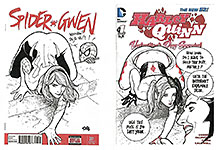
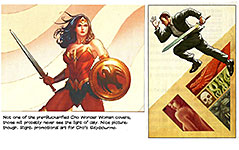
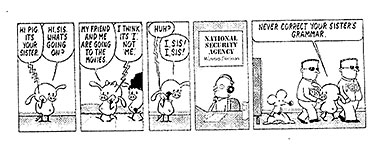
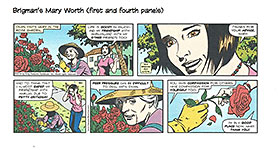


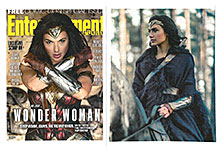
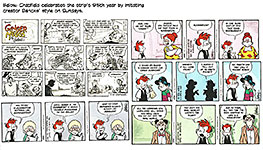
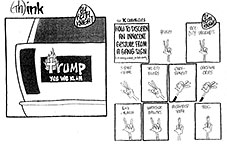
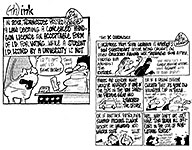

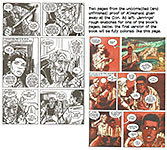
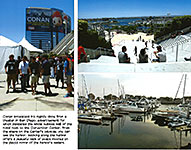
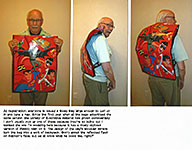
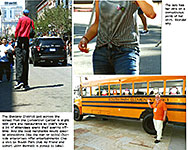
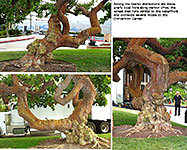
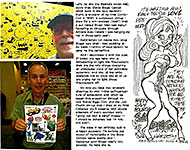
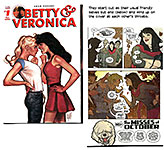
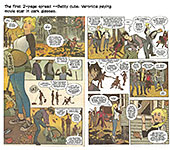

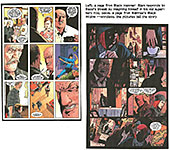
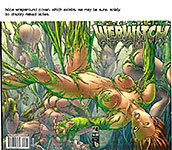
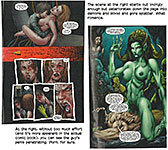
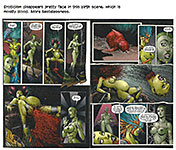
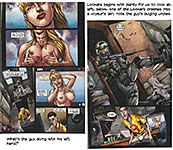
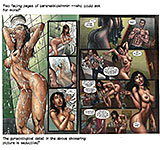
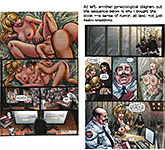
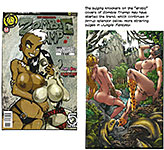
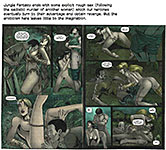
1.jpg)

2.jpg)
3.jpg)
4.jpg)
5.jpg)
6.jpg)
7.jpg)
8.jpg)
9.jpg)
10.jpg)
11.jpg)
12.jpg)
13.jpg)
1.jpg)
2.jpg)
3.jpg)
4.jpg)
5.jpg)
